Allan's Photoblog
CA State Science Fair 2018
This isn’t about W and J. W didn’t compete, and J didn’t qualify for CA.
It’s about me and a remarkable young man I met at the CA State Science Fair this year.
I’ve been judging at the CA State Science Fair for 6 years, including this year. I’ve started volunteering to chair judging panels now, so my name is on some list of judging chairs, and this year, I was asked to chair the panel for Mathematical Sciences, Junior Division. I told Gerrie Peters, who organizes the physical sciences categories, that I was looking forward to something different, beyond my usual physics and experimental focus.
The old Mathematics and Software category had grown too large in recent years, so last year it was split into Mathematical Sciences (MA) and Computational Systems and Analysis (CX), and the previous chair went with CX, while I was asked to chair MA. Unfortunately, last year, there were still far more students in CX than in MA, and this year, the organizers attempted to rebalance the load by moving students working on neural networks and machine learning into MA, if their projects had a focus on theory rather than data. However, the divisions weren’t always clear cut, some students asked to be reassigned back to CX, and all those requests were denied. We chairs (in the Junior and Senior MA categories) were asked to accommodate the neural network or machine learning students, which I thought meant we had to expand judging beyond pure mathematics. I informed my fellow judges by e-mail.
About four or five of our students (out of nine in total) stated in their abstracts that they used neural networks or machine learning in their projects, which was a bit of a relief to me, since I had dabbled extensively in neural networks as a hobby during my grad student years. I had been worried that I’d be judging only pure mathematics, and although I’m no slouch when it comes to math, it’s not my specialty. I’ve learned over the years that different sciences have different vocabularies, e.g. when astronomers talk about Be stars, they’re not talking about stars made of beryllium (which I — a physicist — thought for a split second (but only a split second because I know that Be is the rarest light element)) but rather stars in class B, subclass e (e for “emission”, referring to specific emission lines, usually one or more Balmer emission lines). The different scientific vocabularies are not a problem for me, but it does mean I have to learn the language, which means a little extra time and effort. But with neural networks, at least I was on familiar ground. Also, with only 9 students, we judges would have plenty of time to conduct interviews.
(Anthony and Phil were two of my co-judges, both from Aerospace. I think Phil is in cybersecurity, and I’m not sure about Anthony, but I think he’s a manager. Tom, our other co-judge, is an engineer at a company I don’t remember, but he hasa strong interest in pure math.)
So, after meeting and getting to know each other, briefly, and after introducing ourselves to the students yesterday, we started our interviews at 8:30 AM. I got through 6 interviews by 10:30 AM, which was our break time. While I was impressed by one or two students, including a student who did a mathematical “proof” (really a demonstration) of Pappus’ Theorem using circle inversion and a Javascript program, as well as a student who used a neural network (as well as other methods, including logistic regression) to study the progression of Alzheimers’ through a 7 year database of Alzheimers patients (in order to predict Alzheimers progression and allow for earlier treatment), the thing I noticed about almost all of the neural network projects is that the students treated neural networks as a black box. In fact, I think only one or two wrote their own neural network code, while most downloaded NN code or used NN code built into some Python libraries. In my opinion, NN code isn’t hard to write — just formulate the mathematics as linear algebra and write simple code to do the multiplication and back-propagation. In IDL, it takes less than a page of code; in Python, it might take a page, maybe less. And even if the student doesn’t write the code himself or herself, I think it’s important that he or she knows what’s going on under the hood. If a student uses a big software package, like GEANT or GALPROP or any number of biophysics packages, then it’s okay not to know the underlying code or mechanisms, because the packages are simply far too big and complicated. But NN’s are simple, so they should know. (The student who did the Alzheimers project did seem to know his stuff for NN’s, at least better than the other students.)
As we were going on break, Phil caught me and said “I think I’ve got a problem with project 7. That one is way over my head.” I hadn’t seen #7 yet, but I told him I’d see #7 next, and we could discuss it at the break and during lunch.
During the break, Tom — who had interviewed #7 before the break and agreed he was impressive — mentioned that #7’s abstract had caught his attention the day before, and he had done some reading on the subject — visibility graphs and visibility graph analysis, particularly rectangle visibility graphs. He agreed to describe the subject and the project to us before we left break, and we left late, at 11:10 AM.
I interviewed student #7 first, after the break, and I was immediately overwhelmed. As expected, I had difficulty with the language of the graphs. Graph elements that he called “vertices” and “edges” I might have called nodes and lines (or connections). I later verified that he was using the proper nomenclature for the field. I had some ongoing confusion about graphs vs. visibility graphs vs. representation graphs, but I got the gist of the underlying mechanisms. Then he started describing things like n-dimensional hypercube representation graphs and so on, and again, while I was familiar with the words, I kept having to ask him to describe how he was using the words. One huge portion of his display was a proof of something, and I wasn’t clear what was proved and said that I simply didn’t have time to verify his proof line by line. I asked, and he assured me that he had shown his proof to his mentor at MIT and that his mentor had confirmed that the proof was valid. Later, he explained a formula for minimal embedding dimensions for rectangle k-visibility graphs. Maybe that was the goal of his proof; it was definitely the focus of his project. (Tom had described k-visibility to us during the break, so I wasn’t completely at sea — Tom’s 10 minute description was invaluable). The student showed how the formula applied to some sample graphs he had on his display. Finally, he talked about how Gray Code applied to his visibility graphs.

Tom’s tutorial during the break had been limited — by necessity — to two dimensional examples, but it allowed me to understand the underlying focus of the student #7’s presentation. What really impressed, though, was that he generalized from 2 dimensional, low-k cases to n-dimensions and any k. I was in over my head, but assuming he wasn’t blowing smoke, I had to be impressed.
All in all, while I had spent 15+ minutes interviewing each of the other students, I spent about 25 minutes with this one, grappling with what he was telling me. (In contrast, student #9 did a project on testing whether very, very large numbers are primes, using a probabilistic calculation (rather than a much slower, though more accurate, deterministic calculation). She was very articulate and enthusiastic, and her presentation was clear and extremely well done. Her presentation was engaging, just challenging enough to be interesting without being overwhelming and intimidating, as #7 was. I later told the other judges that, as impressed as I was by the others, she was the only student I actually had fun talking to. I could have spent another 10-20 minutes with her, beyond my regular time.)
After I dismissed the students at 12:30 PM, the end of interviews, I joined my co-judges for lunch in our assigned meeting room. It was pretty clear we were giving #7 first place; it wasn’t even debated. Our second and third place students were #1 (Alzheimers progress prediction using neural networks) and #9 (Fermat vs. Brute force algorithm to determine primality), but we discussed for about 10-15 minutes which would get which. Both had great strengths, and both had (minor) weaknesses. In the end, we gave second place to the girl determining primality, on the basis of the strength of her presentation, although the boy who applied NN’s to Alzheimers patient data was somewhat more impressive in his data analysis and might have more real-world impact. But it was very close. We also decided not to award 4th place (since we had so few students) or Honorable Mention, but we chose one project for 4th place just in case it was required by the fair. When I turned in our final results at 1:30 PM, I was told that a 4th place finisher was required, so I wrote in #6, the girl who had demonstrated Pappus’ Theorem with Javascript code.
Before we turned in results, though, we had to decide on which of us would represent our winner for consideration for Project of the Year, Junior Division. Project of the Year is selected as the best project in the fair (separately between Junior and Senior divisions), selected from the first place finishers in each category. That meant our Mathematical Sciences winner (#7) would be competing against winners from other categories, like atmospheric science, biological sciences, physics and astronomy, applied mechanics and structures, etc. There are 23 junior division categories, which meant our one guy would have to compete against 22 other winners.
Not only that, but the student wouldn’t be presenting his project. Instead, the judging panels from each category would have to send a representative to the Project of the Year meeting to present the winner to the other PoY representative judges. Then, over the course of a couple of hours, the PoY judges would debate among themselves which was the best of all projects, and votes would be taken until a final winner was selected.
I was the panel chair last year for Applied Mechanics and Structures, and since nobody else was available, I also presented our winner (which I don’t remember) for Project of the Year. I quite enjoyed doing so, and I really enjoyed hearing about other winning projects from other categories. Last year, I think we voted the Microbiology (Medical) winner as PoY.
This year, I had cleared my schedule to be PoY representative if nobody else could do it, but I strongly encouraged our other judges to give it a try, given how much I enjoyed it last year. Anthony had an afternoon meeting to get to. Tom had an appointment in the afternoon, but he said he postponed it. Phil was available.
I said that, while I was willing to do it, I didn’t think I’d be able to do him justice and give our winner a proper presentation at the meeting. Since Tom had given us a tutorial during our mid-morning break, we finally decided that he’d do it. However, since he hadn’t presented for PoY before, he asked me what he’d need to do. I told him that they’d have a photo of the project board, projected on the wall, and I told him to expect to take maybe 3-5 minutes to give a summary of the project to the other judges. He asked if he could draw on a whiteboard, and I said they’d probably have one. If he could give the same kind of tutorial to the other judges as he gave us, he could really make the case.
Mainly, I told him that I really believed in the project and that I thought it deserved PoY, or at least deserved to be in the running. I said that if a kid had built a rocket ready to go to Mars, then I’d give PoY to that kid instead, but otherwise, I thought ours was deserving. I told Tom to emphasize that the project was a pure mathematics research project and that, although most of the other categories are experimental or applied, I wanted Tom to argue that the purely theoretical focus of our winner should not be held against the student. I told Tom that, although it’s not my field, I thought the research went beyond undergraduate level and instead seemed like graduate level research.
We said our farewells to Anthony and Phil, and Tom and I walked over to where the PoY Junior Division meeting was going to be held. I turned in our results in an office nearby (adding in our 4th place finisher), and I left. I bought some souvenirs from the fair, ran into Phil outside and chatted with him and a friend of his, and then I went to the King Tut exhibit. I bought some more souvenirs there, too.
That evening, as I sat in W’s piano lesson, I checked on the web and found that our Mathematical Sciences First Place Winner had also been awarded Project of the Year! I immediately checked my e-mail and found a note from Tom, "Our man Espen Slettnes, #J1507 was awarded the Project of the Year award for the junior division.” Phil even sent a photo.
I immediately e-mailed Tom and Phil to thank them for the news and photo.

Congratulations to Espen Slettnes, First Place Winner in Mathematical Sciences, Junior Division, of the California Science Fair 2018 and Winner for Project of the Year (Junior Division)!
Japan Family Vacation 2018 — Days 6-7

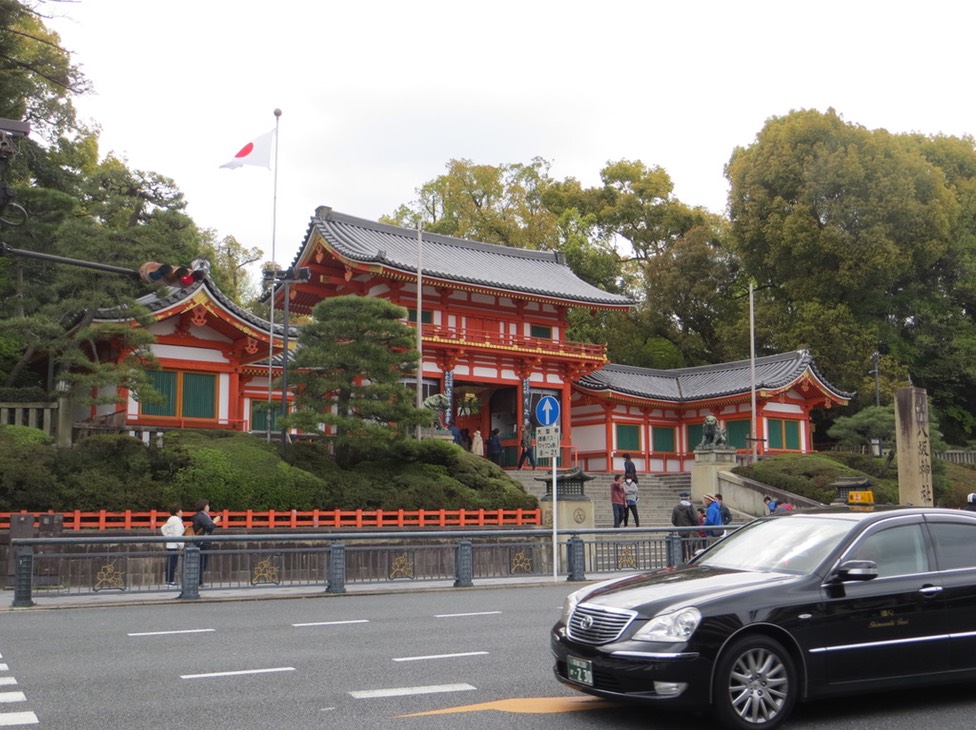



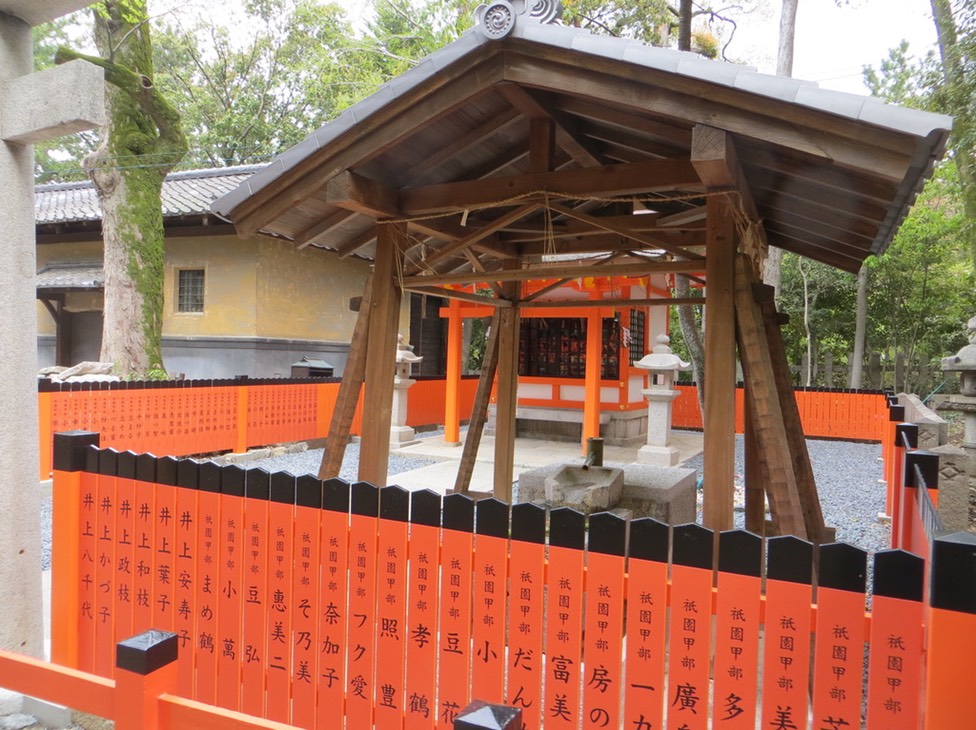



After breakfast — at which Hsuan, W, and I wore our yukattas — we walked to the Yasaki-jinja shrine, which is a shrine complex only a few blocks away from Gion Shinmonso, through some shopping streets and at the southeast part of the Gion neighborhood. We got there in the early morning, and many of the usual food stands were still setting up. I noticed that many of the lanterns decorating the shrine were marked in English lettering — Franklin tailored, Noster, Natural Beauty, and roth Alley Bar, to name a few. I can only assume the Kanji labeled lanterns were similarly labeled by businesses that purchased the lanterns and donated them to the shrine.
Maruyama Park is adjacent to the shrine, so we walked up there a bit. J wanted ice cream, but the ice cream store wasn’t open yet, and eventually, we left to return to Gion Shinmonso to freshen up a bit. The futons in our room had already been stored.
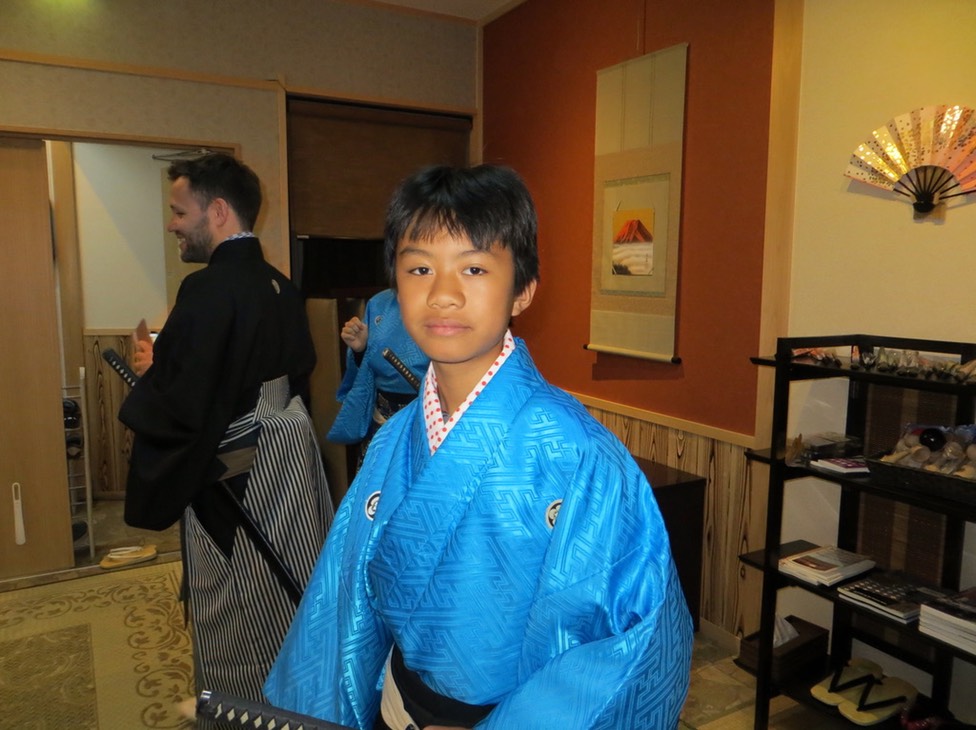
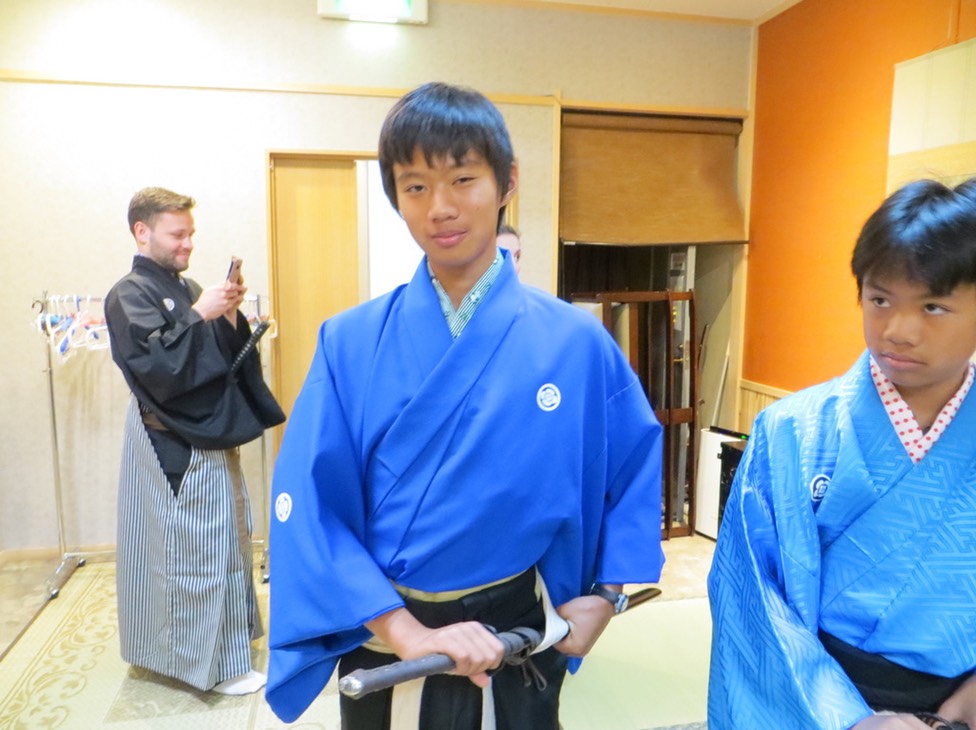





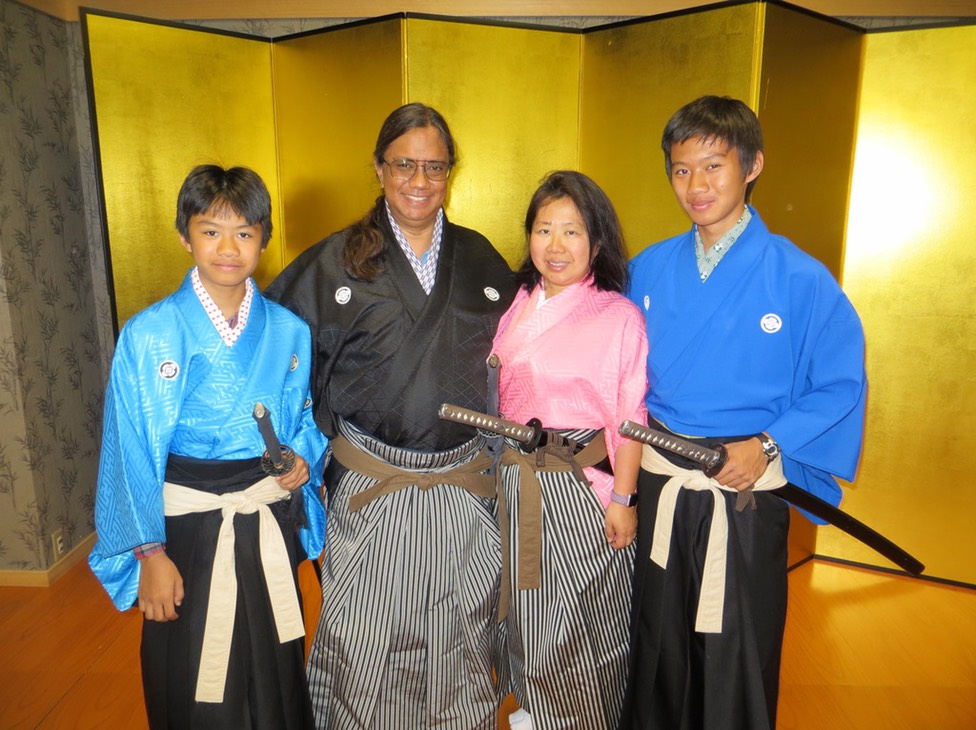
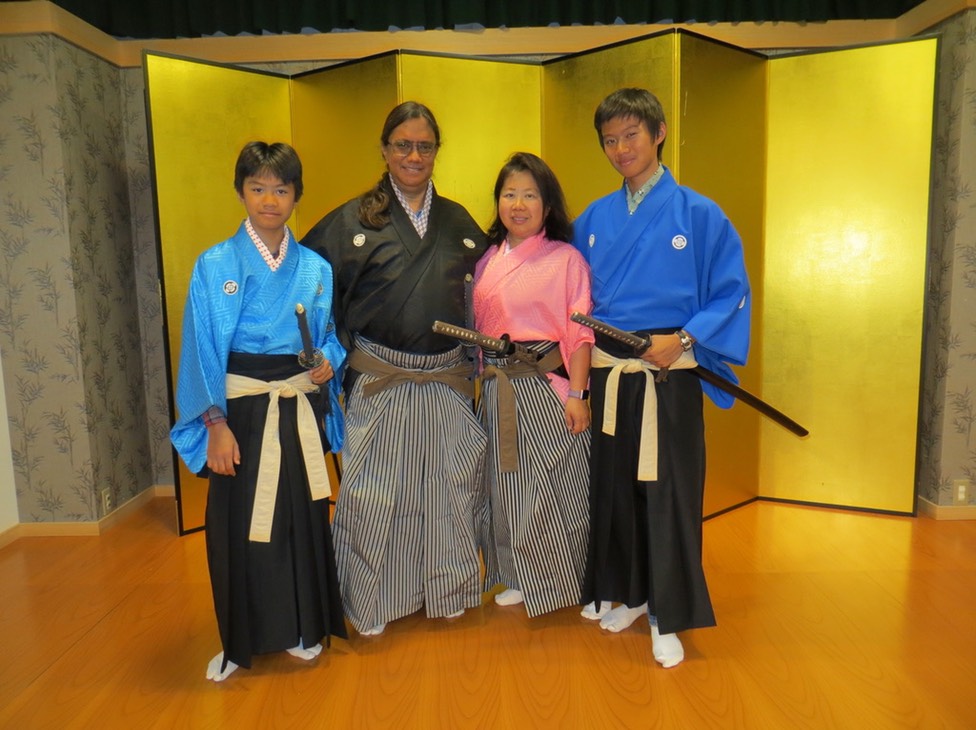
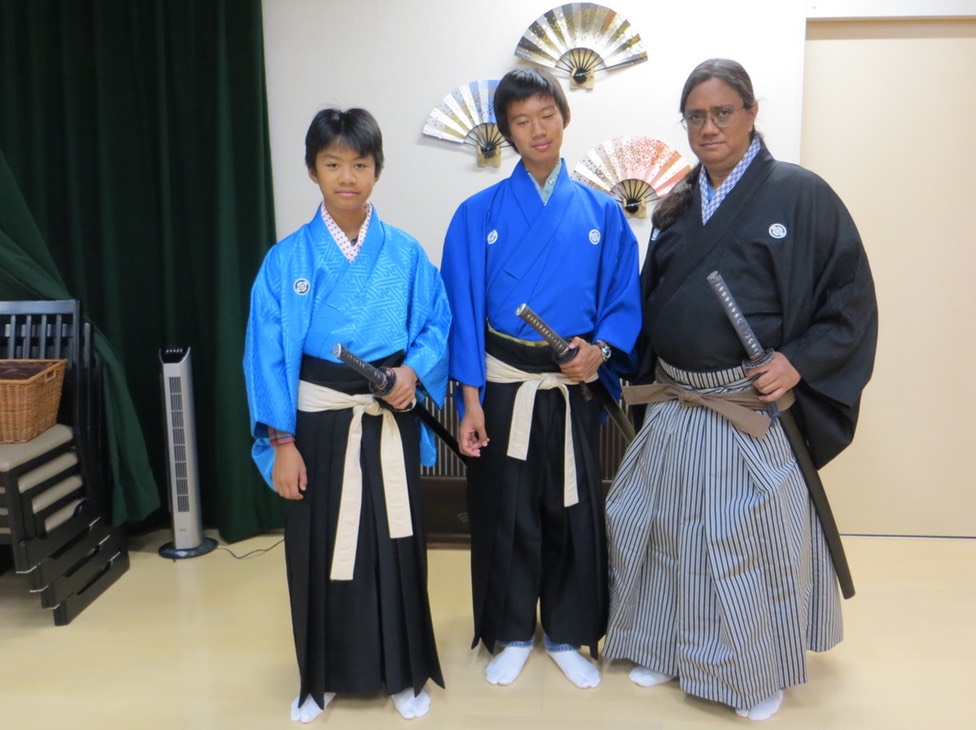


On April 5, I think after we arrived at Gion Shinmonso, I booked us for the two hour lesson at the Samurai Kembu Theater, since the Kyoto Samurai Experience location hadn’t responded to my e-mail. I booked through TripAdvisor/Viator.com. We were scheduled for the 11:15 AM two hour lesson, which included not only some basic samurai sword training, but also some folding fan technique and dressing up in samurai kimono.
Kembu (actually more often spelled Kenbu on the web) means sword dance, which is a traditional Japanese dance form involving samurai sword and fan techniques. The Samurai Kembu Theater is located just a few minutes walk from Gion Shinmonso, and it is one of the more famous Kenbu groups in Kyoto.
We got there at 11 AM, along with others who signed up for the 1 or 2 hour classes, and we registered. About half of the 11:15 AM group were signed up for the 2 hour session, and the rest signed up for the 1 hour session. We chose our samurai costumes ahead of time, according to pattern and size. We were given swords according to our size — men’s swords, or women’s/children’s swords. The swords aren’t sharp, except for the pointy ends, but they’re made of a zinc alloy that is both shiny and heavy. The lesson was a real workout. You can buy these swords from many different stores for home decoration.
After belting on our swords, we were drilled in basic slashing/swinging techniques, as well as drawing and sheathing our swords. Then we were divided into three groups, and one group at a time went into another room to put on the kimono, hakama (trousers), and belts, while the rest stayed in the main room to continue sword drills.
Once dressed up and after the final drills, the 1 hour class people had their photos taken by the instructors, and then they left after being given certificates. Afterwards, we in the 2 hour class had our photos taken, and then we received additional instruction on using the Japanese folding fans for interpretive dance techniques.
Finally, we were given choreography instruction for a Kembu dance, and each family group performed for the rest, while the instructors either directed us from the sidelines or took videos with our cameras.
Afterward, we our certificates, got out of our samurai clothing, signed guest comments, and departed. We went back to our room, then went out for beef and rice bowls for lunch (having decided that a highly rated teppanyaki bar might be good but not what we usually think), and then returned to our room.

On our way back from lunch, we were fortunate to cross paths, very briefly, with these three apparently authentic Maiko -- identified by their white make-up (tourists don't bother -- too easy to smudge when you're stuffing your face with lunch and tasty confections), their hairstyles, and the extra-elaborate obi (darari obi, worn exclusively by maiko). (I say "apparently" because I thought Maiko wore high platform sandals, but perhaps there's a reason for these not to do so. On the other hand, later that evening I did spy a maiko running (!!!) to some job -- she seemed to be late and in a hurry -- and I don't think she could have been wearing the high sandals.)
There are photo studios that do "maiko transformations" for customers, but I get the impression that's for tourists who want to get photo shoots of themselves dressed and made up as maiko, not to walk around town dressed as such.


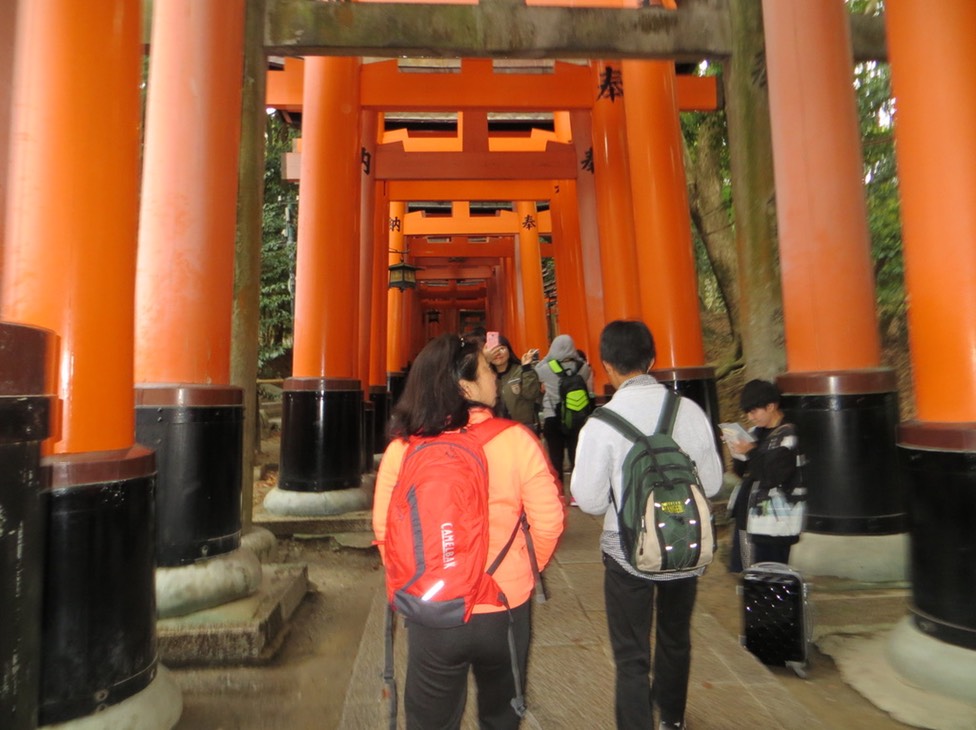
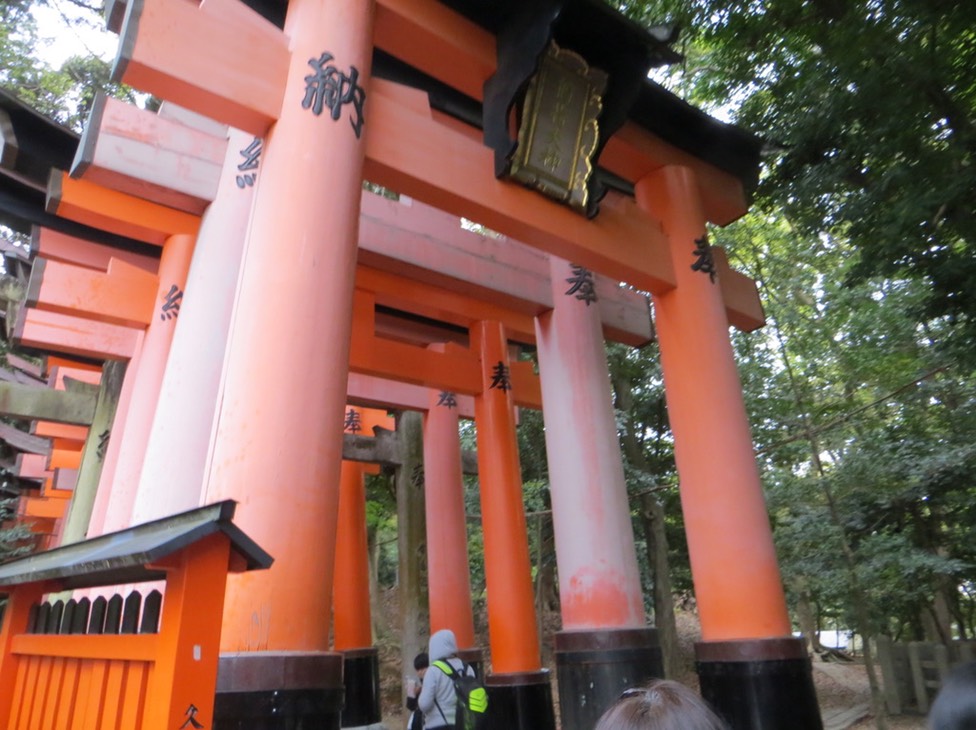


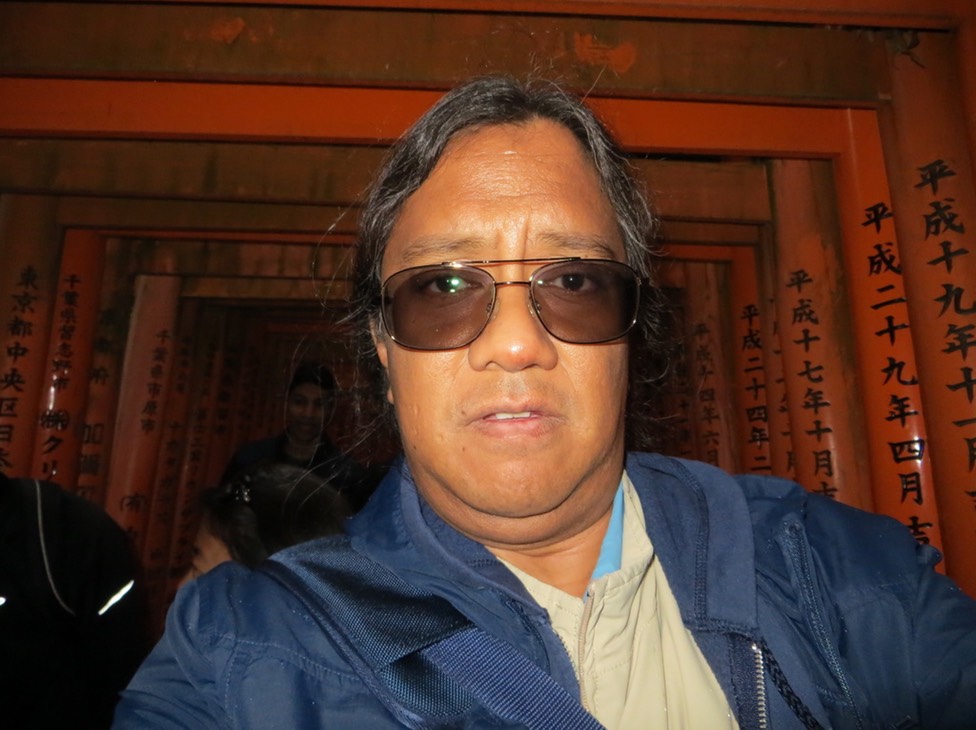




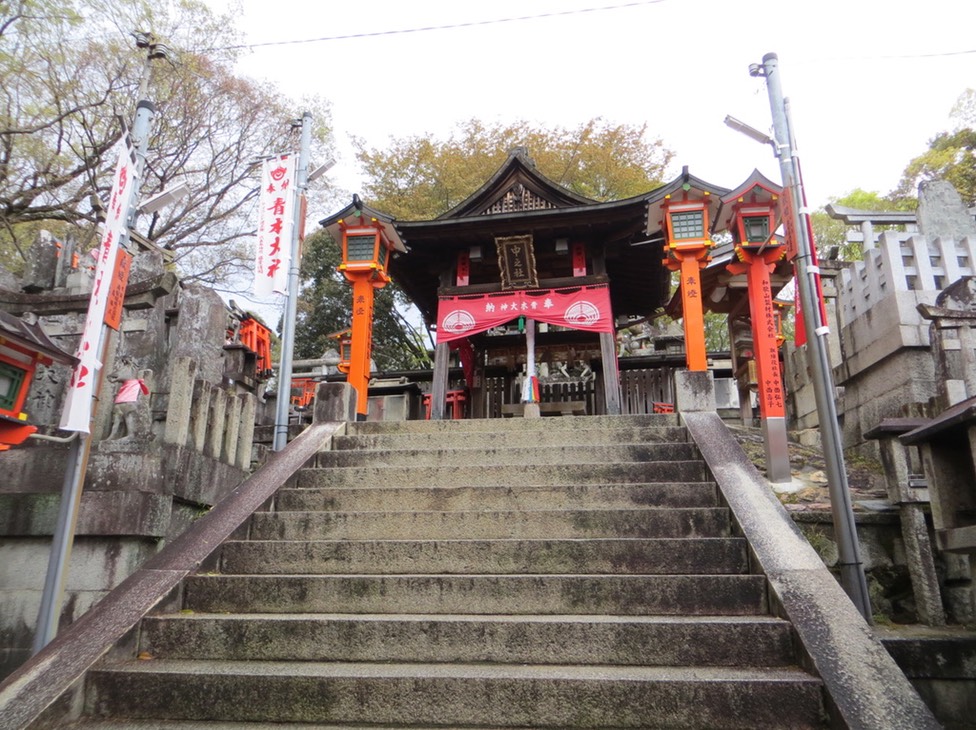
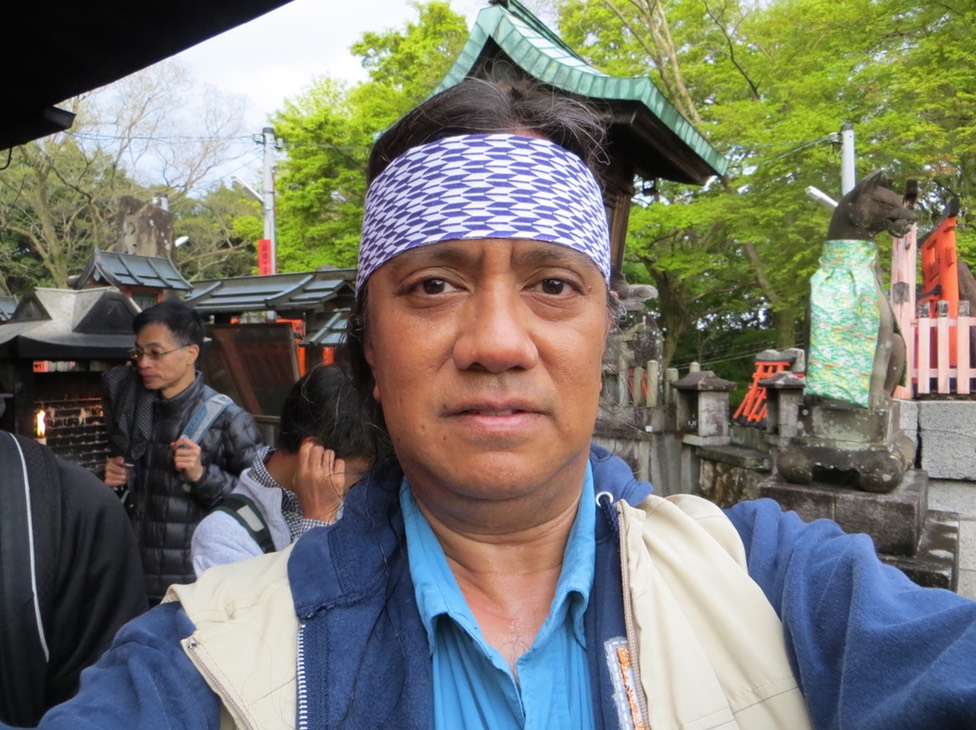

Our final destination for touring was the Fushimi-Inari Shrine, a short train ride away from Gion. It’s another complex of shrines, as are many others, but this one is famous for not one torii gate (those stone or wooden gates that kind of look like the letter pi) but thousands (seemingly) of torii gates. These gates are donated to the shrine by businesses or, one guesses, wealthy citizens, and they come in all sizes. In fact, we saw signs along the way that listed prices for the gates, apparently based on size, ranging from miniature gates maybe a foot or two tall to the big gates maybe a dozen feet tall.
Inari is the god of rice and is apparently the patron of business, which explains all the businesses sponsoring torii gates.
The shrine complex starts at the base of Mt. Inari, and then the paths lined with the gates start winding up through the forest and up the mount. We went through at least a thousand gates, and though I was worried about not returning to the Gion Shinmonso in time for our 7:30 PM dinner — we had selected sukiyaki instead of kaiseki this time — we decided (at W’s and J’s urging) to press on to the top of Mt. Inari. The boys spent time mocking Hsuan and me for being old and slow, but we still pressed on.
By the time we reached the peak, at 233 meters elevation, I was not only soaked by the drizzle and rain but also by the sweat throughout my shirt, vest, and hoodie. The weather was cold and wet, explaining the layers of outerwear; we had also borrowed another umbrella from the ryokan. I was sweating so hard that my face was steaming at the top of the mountain. About halfway up the mountain, I had to switch the order of my vest and hoodie, so I wouldn’t soak through the vest, which I had intended to wear on the plane flight home.




We managed to get back to our room a little before 7 PM, and I made a quick stop by the public bath downstairs and returned in time for dinner. We had chosen the sukiyaki dinner, and the middle-aged lady brought our first items and the grill. The food included a ludicrously large plate of vegetables as well as a huge plate of meat, plus sashimi as at all our dinners.
Unlike the kaiseki, our servers weren’t coming up to serve us periodically, and we cooked ourselves. In any case, we couldn’t finish all the vegetables, and finishing the meat wasn’t much easier. The young man (whose name — along with the women’s — I didn’t ask and wouldn’t remember) eventually came up to take away our remainders, but we hadn’t even gotten to the udon noodles, so we asked for a few more minutes.
Dessert was some sort of Japanese honeydew, plus a few cubes of mochi.
The young man and the elderly lady came by again to set out our futons and bedding, and we chatted a bit. It turns out they say Okini instead of Arigato in Kyoto.
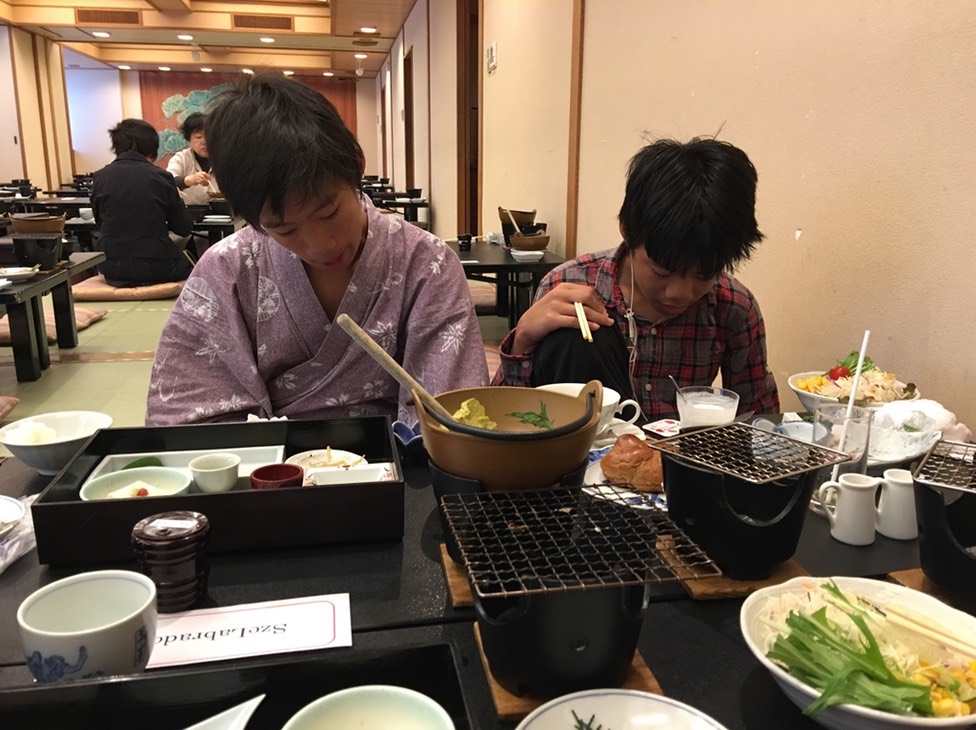

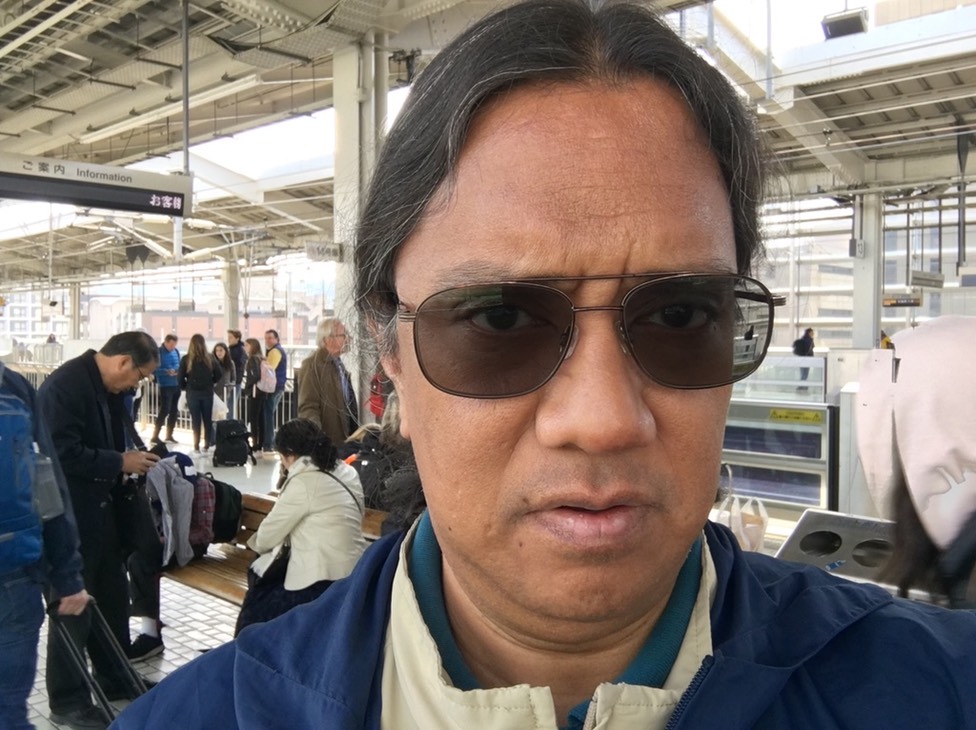


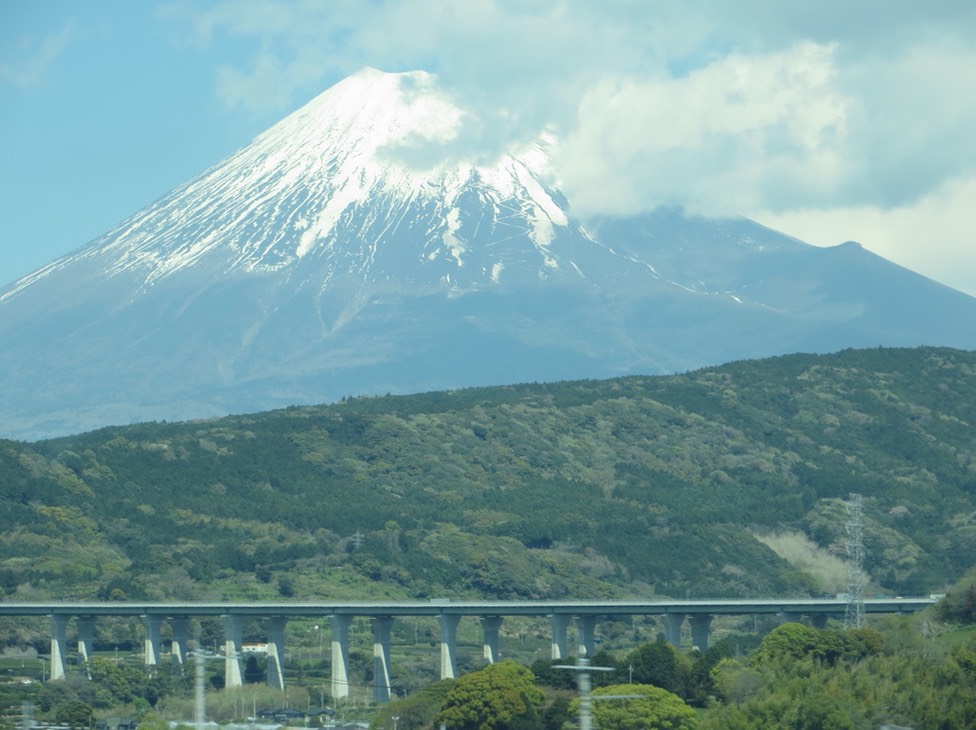
After breakfast on April 8, we spent the entire day traveling by Shinkansen from Kyoto to Shinagawa station in Tokyo, then by Narita Express to Narita International Airport. At Kyoto station as well as at Narita, I kept trying to spend whatever Japanese coins I had, because banks don’t exchange coins, only bills. I snagged some sake flavored KitKats, which are popular in Japan, as are the many other flavors of KitKats we don’t get in the US. In the end, I was reduced to plugging coins into vending machines, buying too much Coke before remembering I like the bottled green tea as well.
We arrived at LAX on April 8, Sunday, at 9:50 AM, and had the usual slow going through customs and border enforcement, though I tried to use the Mobile Passport app (which didn’t work for whatever reason). The guy who drove our Uber home kept breaking hard or accelerating hard, which made me queasy after our long trip. Then the boys and I went to a Spanish Mass that used to be called bilingual, but it was all in Spanish, which I suddenly remembered less well than Japanese.
But I was glad to be home.
——
All the photos from this trip are on my Flickr page, too. I found out that Photos for OS X didn’t properly import all the time zone, time, and date data for all of my photos, which forced me to go through all 451 photos and adjust times correctly. That part wasn’t fun.
Japan Family Vacation 2018 — Days 4-5







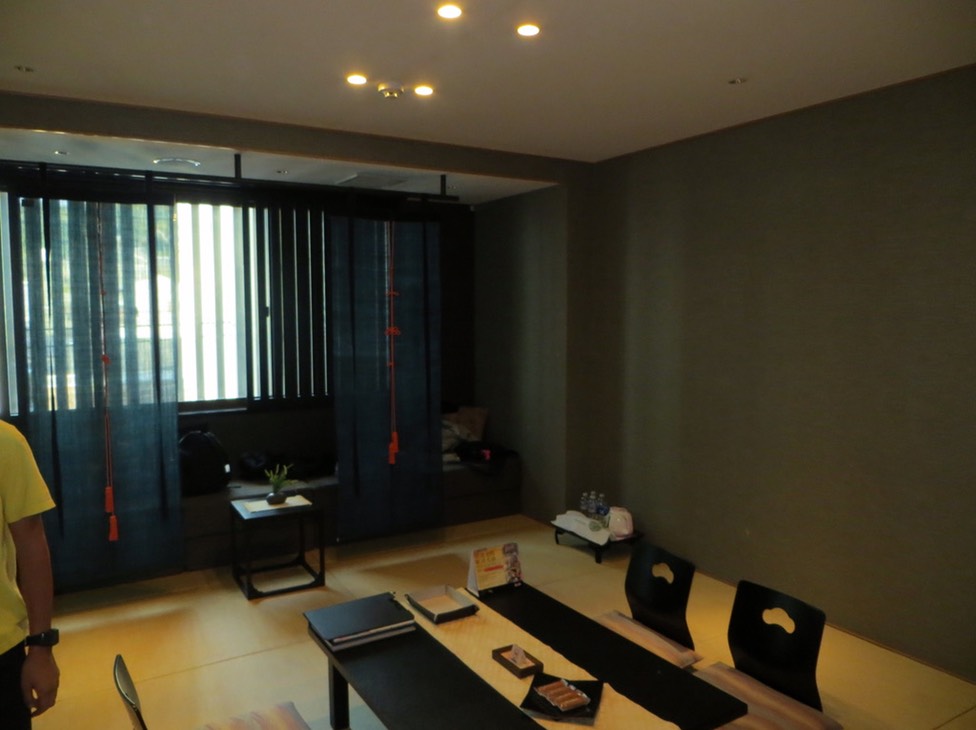

On April 5, our fourth day of vacation, we checked out of the hotel and got on a Shinkansen bullet train to Kyoto, from Shinagawa station. When we got the tickets, I had an embarrassing moment when the ticket agent said my credit card was over the limit. I gave him my other credit card. It wasn’t until a few minutes later, after I turned on the WiFi hotspot, that I found out that my credit card was nowhere near the limit, but rather that Bank of America had suddenly gotten suspicious of my travel charges — despite the fact that I had logged a travel warning with them weeks before. This ticked me off because The BofA Visa is a special travel Visa that doesn’t charge foreign exchange fees, and the Shinkansen charge was the single largest expense on our trip. I clicked on my BofA iPhone app to approve the charges, but I was still steamed.
That embarrassment aside, though we got the roundtrip tickets on the Shinkansen, and we also reserved our return seats on Narita Express for Sunday.
The ride, as expected, was fast and incredibly smooth. We got off at Kyoto Station and then took subways to Sanjo Keihan Station. The subway system in Kyoto is not nearly as complex as it is in Tokyo, although the disadvantage is it has fewer stations near places we might want to visit. Still, Sanjo Keihan was only a few blocks away from Gion Shinmonso, the ryokan where we’d be staying.
For Kyoto, I very much wanted the boys to experience staying in a ryokan, a traditional Japanese inn, where the hospitality is more personal — almost intimate — than at a large modern hotel. During my only previous visit to Kyoto, with Hsuan when I was a grad student, we stayed in a single story Kyoto ryokan where our room opened out onto a private garden. I didn’t think we could afford that kind of ryokan this time, but the Gion Shinmonso — a four story ryokan with some modern amenities (like WiFi on all floors) — was well reviewed, located in walking distance not only to the subways but also to Gion, the heart of old Kyoto, and just as important, available during our visit. In addition to having breakfast every morning, we also booked our room with dinner every evening. That limited our dining options to not going out for dinner, but the dinners we had at Gion Shinmonso were so excellent that I didn’t regret missing the restaurants.
Our room was a 15 tatami mat room. We counted 12, but that didn’t include our private bathroom and entryway. We all had yukatas and slippers provided for us, and only J refrained from wearing them. There were public baths on the first floor, and again, only J refrained from using them. I used the men’s bath three times during our stay, before dinners, and twice there was a man and his young son in there, who left around the time I entered. The other time, nobody was there, so basically, I had naked-time in the bath all to myself. The baths were not natural hot springs types of baths that you can find in some high-end ryokans; rather, these were indoor spa types of baths. Still, very relaxing. (Yes, I washed before entering, using the showers and toiletries provided. I had researched the rules of public bath etiquette, but the hotel had posted instructions for visitors unfamiliar with the customs. I washed again upon exiting.)

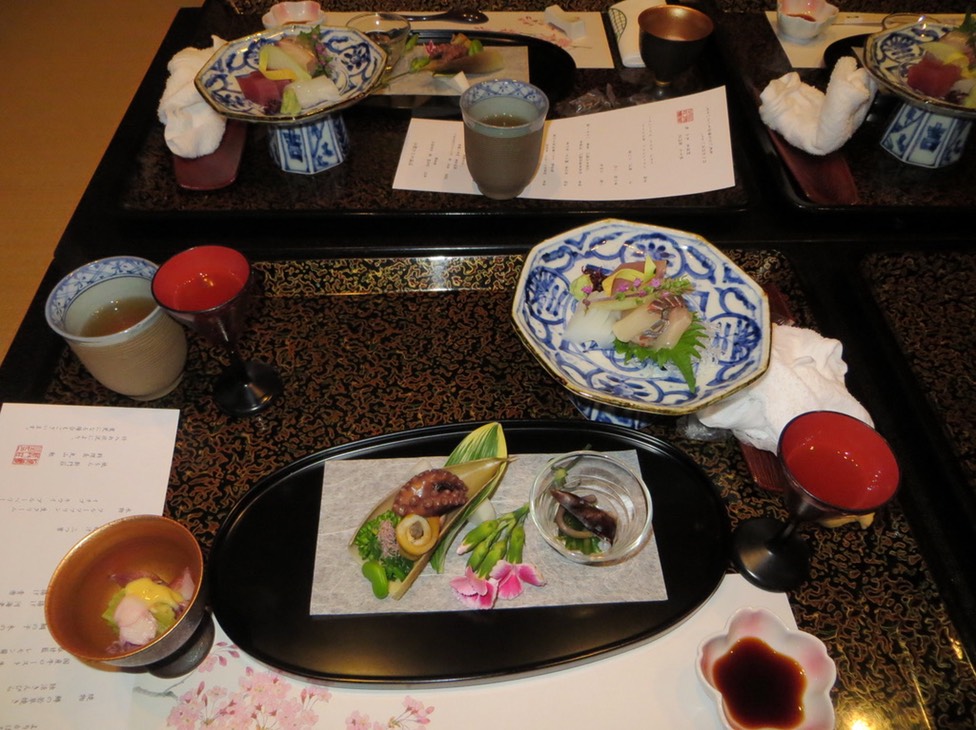






Our first dinner at the Gion Shinmonso — after arrival and after I visited the bath — was our first kaiseki dinner, served to us in our room. Kaiseki is a multi-course meal designed to highlight not only multiple ingredients but also multiple methods of preparation. I won’t bother describing each dish, but they’re all pictured above, for the most part. It’s haute cuisine, and Kyoto kaiseki is the pinnacle of kaiseki. We weren’t disappointed in the least — each dish was exquisite in taste and impeccable in presentation.
We were served at the table in our room by a nice, middle-aged lady in a kimono, who was later assisted by a young man dressed in black. The lady spoke a little English, but the young man spoke much better English and wound up serving as our interpreter for the dinners.
One thing: They started a bit later than our 7:30 PM dinner time, so they must have been rushing to serve all the rooms on our floor. The result is that Hsuan and the boys (mostly J) couldn’t finish each course before the next one came. By the end, J’s tray held a little food from every course. Hsuan and I felt a little rushed.
After dinner, the lady and the young man cleared out the Japanese furniture and laid out futons and bedding for us for the night.
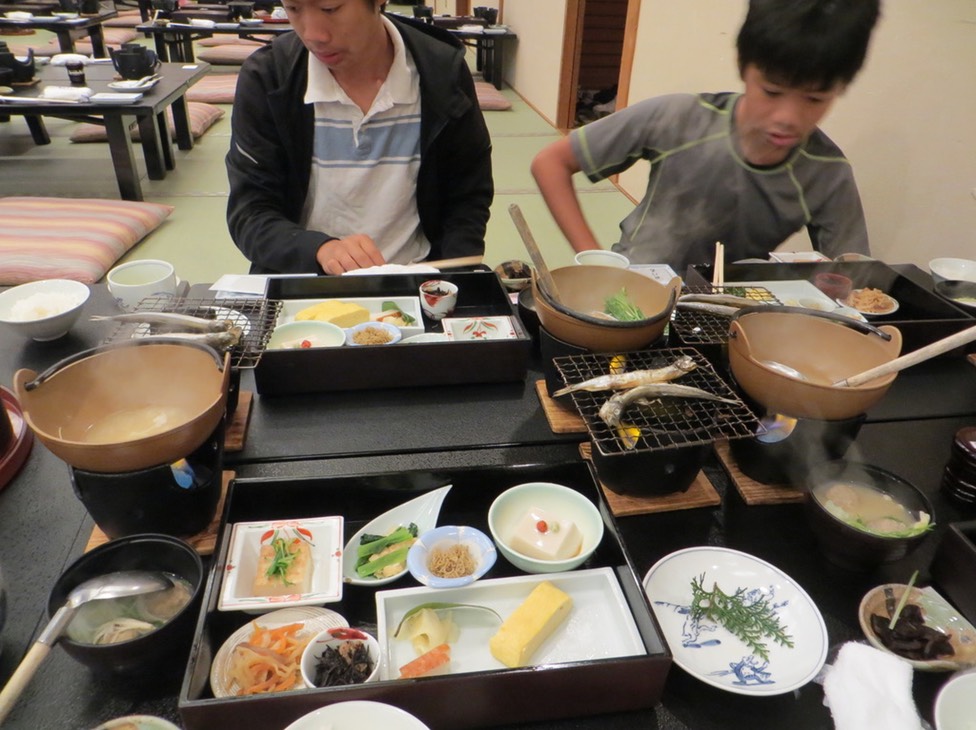





The next day, April 6 (our fifth day of vacation), we went on our only guided tour of the vacation. The first stop was Nijo Castle, the castle of the Shoguns, complete with moat and other defensive measures, because Shoguns, unlike Emperors, had to worry about being killed by enemies.
We walked (sans shoes) on the nightingale floor that went throughout the castle buildings. The floor was made of wood that squeaked like the sound of many nightingales chirping — a sound intended to alert people in the rooms that someone was walking outside — visitors, or assassins.
We visited various rooms where our tour guide (Yuki) said that the Shogun received various visitors, from outer daimyo (those whom he had defeated in battle and who surrendered), to inner daimyo (those who fought for him), to family and others. For the most part, the Shogun sat on a platform elevated slightly above those that others sat on — except the Emperor’s messenger, who when visiting sat on the higher platform.
In some rooms, where the Shogun had to demonstrate his superior authority and military might, images on the walls included things like tigers, but in more intimate or private rooms, the walls were either blank or at least less intimidating.
There was a room where the last Shogun decided to give up his power (for the Meiji Restoration), and another room where he formally announced he was giving power back to the Emperor.
Unfortunately, we weren’t allowed to take photos indoors.
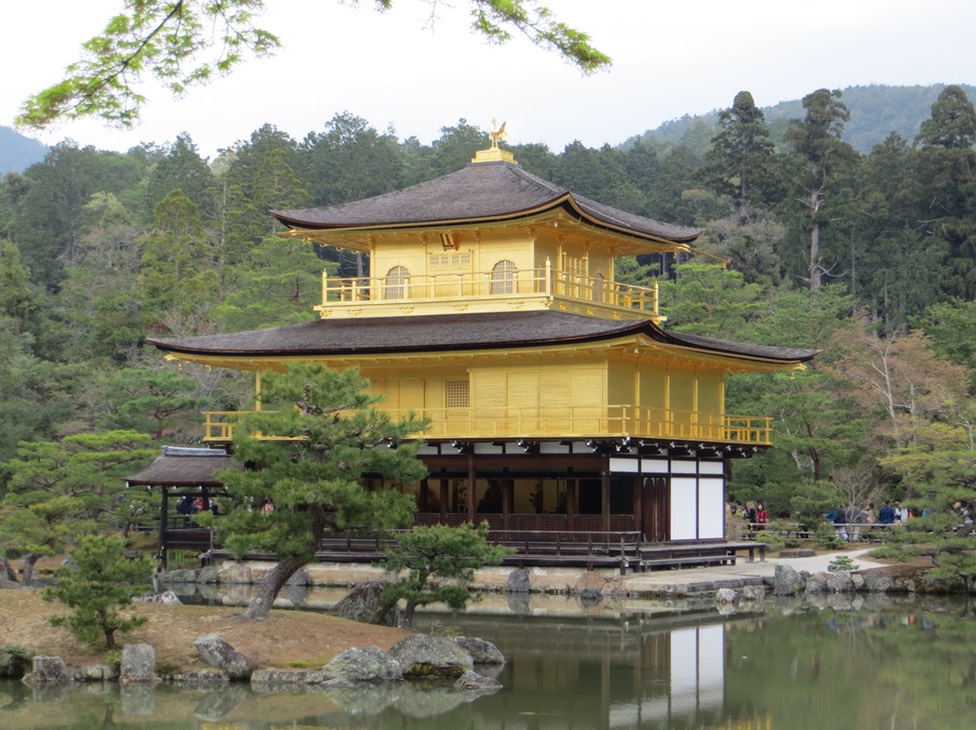
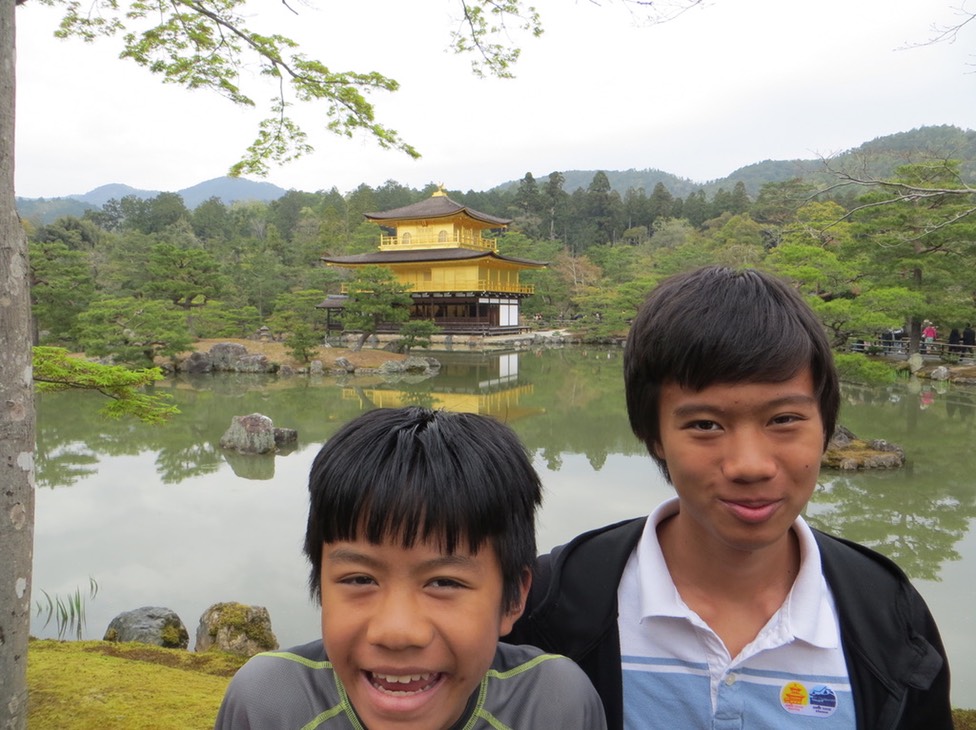
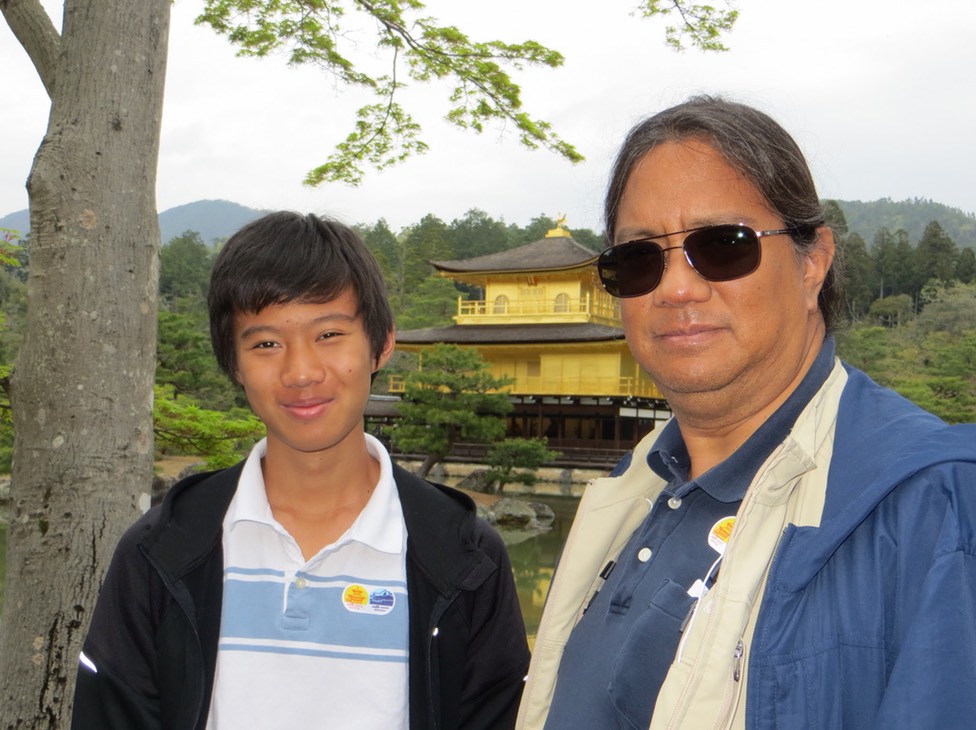
Our next stop was to visit the Golden Pavilion at Kinkaku-ji. What more can I say about a building covered in gold? That’s a lot of gold. The building was originally bought by Shogun Ashikaga Yoshimitsu from the family of a statesman, and later it was converted to a Zen temple by the Shogun’s son.
Visitors aren’t allowed in the temple, for fear of the delicacy of the building and the fact that it has burned down in the past.


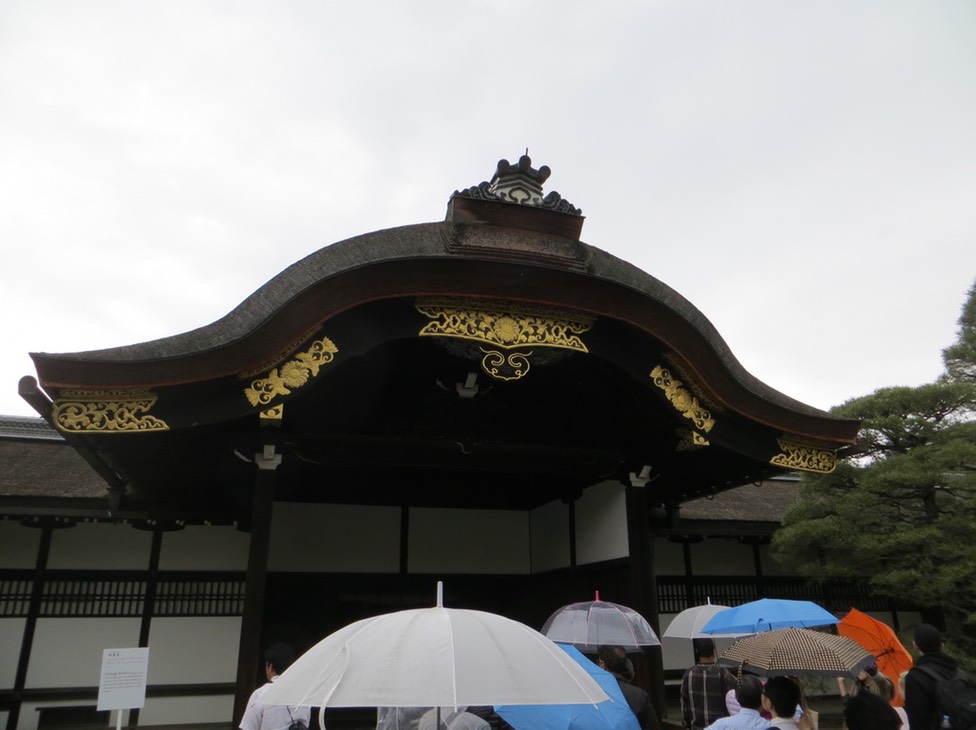

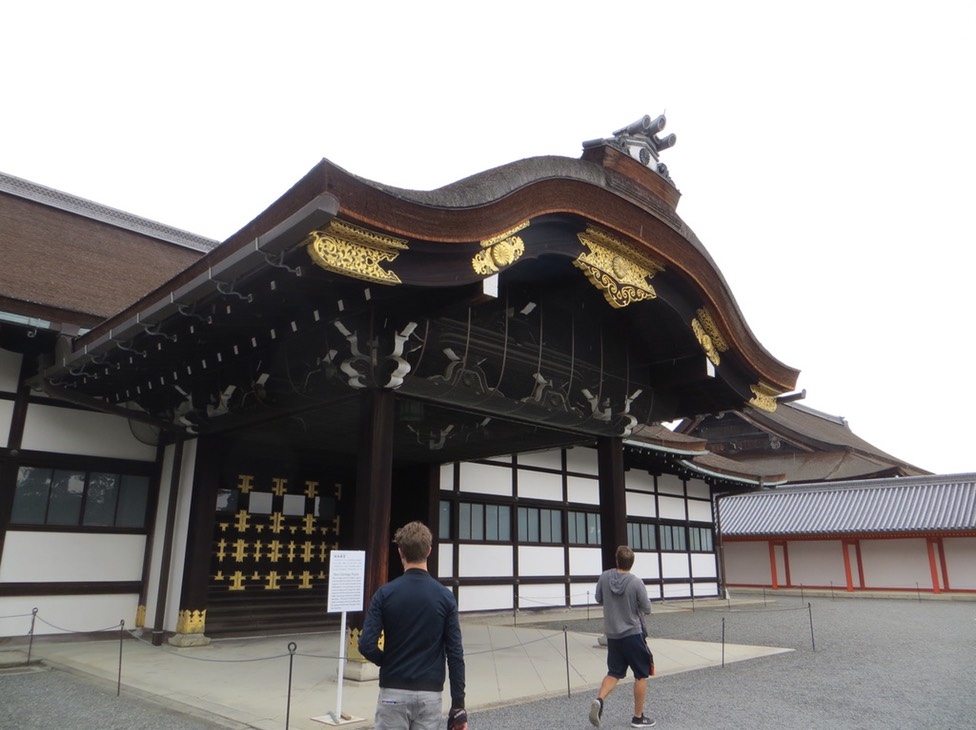





Our next stop — and the start of rain — was the Imperial Palace in Kyoto. Or former Imperial Palace, as the current Emperor lives in Tokyo. As before, visitors weren’t allowed in the bulding, so we mainly walked the grounds. This is the palace where Emperor Meiji took power during the Meiji Restoration, before moving the capital (i.e. his residence) to Tokyo.
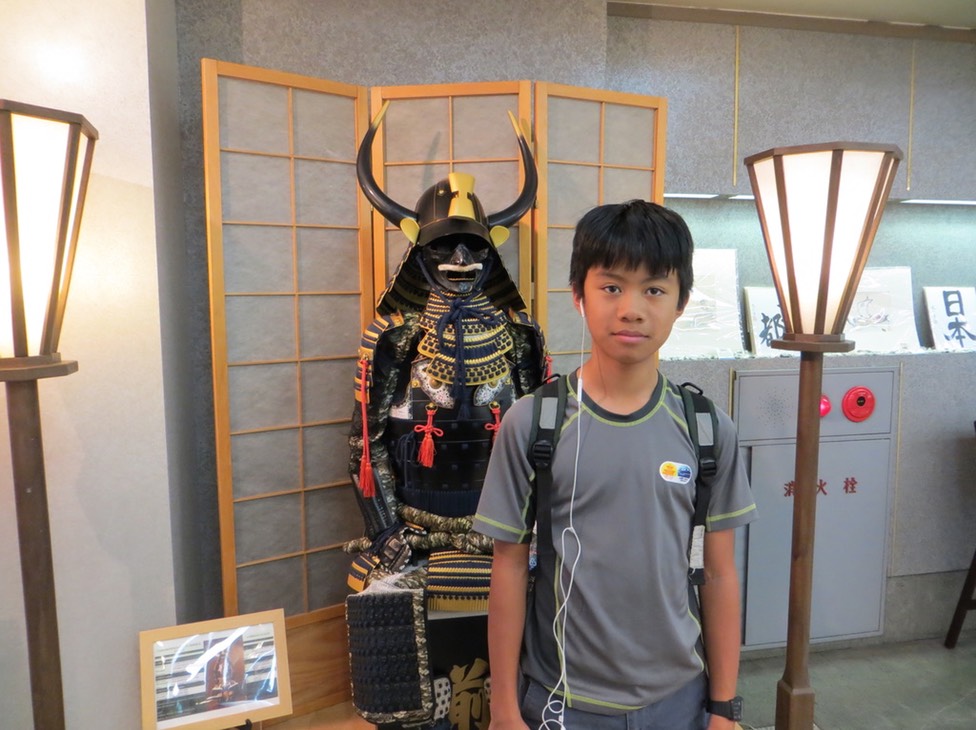
From about 12:30 PM to about 2 PM, we had lunch and shopped at the Kyoto Handicraft Center, where Hsuan bought a bunch of candies for gifts to friends back home, and W and I got yukata for ourselves. J posed in front of this cool set of armor (replica), which was offered at some enormous price.
Lunch was made for Western tourists — chicken nuggets, spaghetti, fries, etc.





After lunch, we got a new tour guide — KC, or Casey — who affected a very effeminate, gay persona that I wasn’t 100% certain was real. Maybe 80%.
Our first stop after lunch was the Heian Shrine. The area is huge, and it includes a large Japanese Garden that, unfortunately, we missed as we visited the main shrine interior. No photos allowed inside, and there was a police-like official there to enforce the rule. People were tossing coins into the offering box and clapping their hands and bowing to the shrine god.
Although the shrine was dedicated to a couple of modern emperors, it seems mainly motivated by civic pride and and civic revival, after the transfer of the capital from Kyoto to Tokyo and after WWII.
The next tour stop, for which I have no photos, was the Sanjusangen-do, or Temple of 1000 Buddhas. By the time we got there, the rain was pouring, and we had only one umbrella between the four of us. I didn’t feel like taking photos outdoors, and photos indoors were strictly forbidden. We walked past the thousand buddha statues, and that number seemed roughly correct, or maybe even a little low if bodhisattva statues are included. I guess each statue is supposed to be different, but I didn’t look closely enough to notice. I did notice that they all needed a lot of dusting.




Our final tour stop for the day was the Kiyomizu temple. I recall visiting this on my prior trip. The main attraction for tourists seems to be the Otowa waterfall with three channels from which visitors can drink. There’s a cool ultraviolet sterilizing station nearby where the cups-on-sticks are sterilized. Each of the three water channels is supposed to grant a wish — love, wealth, whatever — but you’re not supposed to drink from all three, which is greedy and may result in a curse instead of a blessing.
There were other shrines in the area which we didn’t visit, and W and J wanted to take a scenic path up into the hills. However, after walking a bit, Hsuan and I got concerned about returning to our bus on time, so we turned around.
The walk to and from the temple was lined with shops selling souvenirs and food. With all the rain, I would have liked to have stopped off for a hot snack, but I was worried about getting to our bus on time. Hsuan and the boys dropped behind, as we walked through the crowds with their umbrellas, and somehow she and the boys decided to stop for ice cream (despite the rain and the cold air).
While walking, I noticed a high density of women in kimonos. We were told by our tour guides that the vast majority of people — women — wearing kimonos in Kyoto are tourists, some from elsewhere in Japan but many, perhaps most, from outside of Japan. Tourists get a kick out of wearing kimonos for a day, playing dress-up and trying to look like traditional, elegant Japanese ladies. Kimono rentals are a popular business.
The non-Japanese kimono-wearers often give not-so-subtle cues that they're not Japanese, e.g. the most obvious clue being that of speaking (loudly) in Chinese, Korean, or Vietnamese.
Of course, there are also actual Japanese people who wear kimonos at work, like the ladies staffing ryokans like Gion Shinmonso, or at certain restaurants (e.g. the Asakusa Imahan in Tokyo). And sometimes one can see maiko or geiko wearing kimonos in Kyoto.

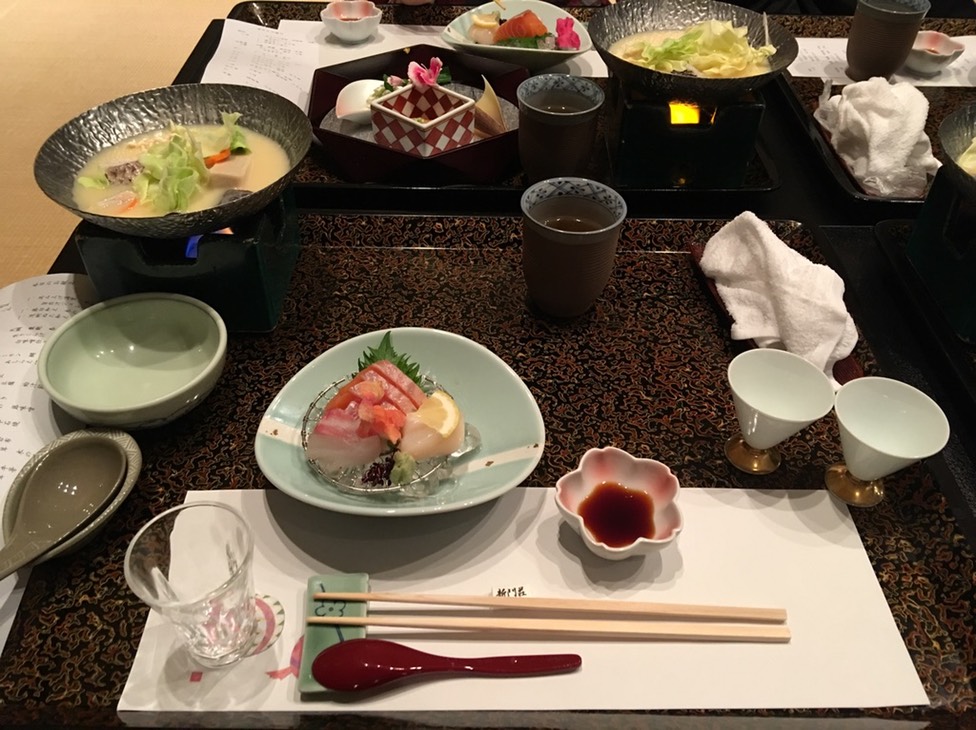
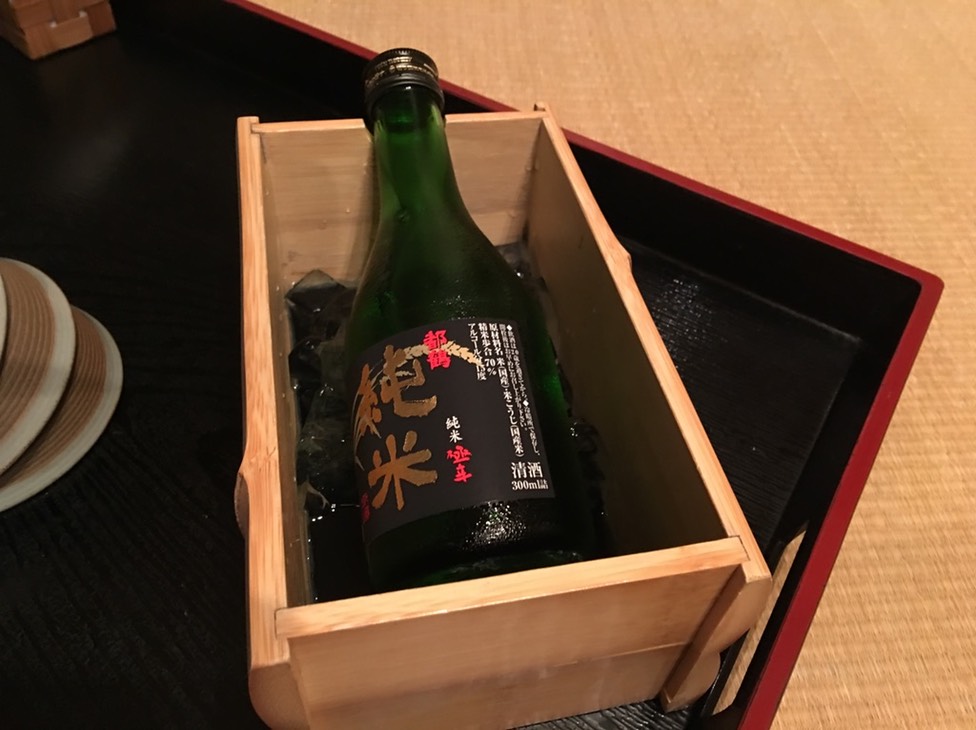







After the tour, we were dropped off at Kyoto Station and again took the subway back to our neighborhood, and then we walked back to Gion Shinmonso. We were thoroughly soaked from the rain, and after hanging up my outerwear to dry (and take out our passports also to dry), I visited the public bath to refresh and rejuvenate.
Our dinner was again kaiseki, served in our room. This time, I should note a highlight, for me, was beef cooked on a hot stone. Another highlight was the mango custard for dessert, and I also had a bottle of junmai sake.
Dinner started at 7:30 PM sharp, and J was able to keep up, though he didn’t eat everything.


In addition to the middle-aged lady and the young man serving us, we were also served by an elderly lady. After dinner, the young man and the elderly lady came by our room to lay out the futons and bedding.
Japan Family Vacation 2018 — Days 1-3

Since the boys are going to two different schools, they tend to have different vacation schedules, but luckily this year, they have Spring Break during the same week, 4/1-4/7.
My work as a physicist brings me to international conferences at least once every two years. I could possibly go to more, but I don’t like to travel much. However, my international travel has given me a somewhat cosmopolitan perspective that I can provide my own boys and which I didn’t experience during my own childhood.
In 2013, we visited Italy as a family, when the boys were attending the same school. It’s one of my favorite countries. Not only did I propose to Hsuan in Venice right after the 1995 ICRC, but I simply love the country, the food, the atmosphere. As I pointed out to the boys, it’s the location of two of the great periods in human history — the Roman Republic and Empire, and the Italian Renaissance.
I decided a few months ago that we’d visit Japan during their joint Spring Break. Back when Hsuan worked in Japan, I visited while still a student, and I noticed how safe I felt walking the streets anywhere and at any time. When so much of Europe is dangerous due to attacks by terrorists, I decided that Japan would be the place to go. Plus, like Italy, there’s great food and great history to enjoy.
I decided we’d visit Tokyo to get a taste of modern Japan, and we’d visit Kyoto to stay in a ryokan and try to get some more traditional Japan.
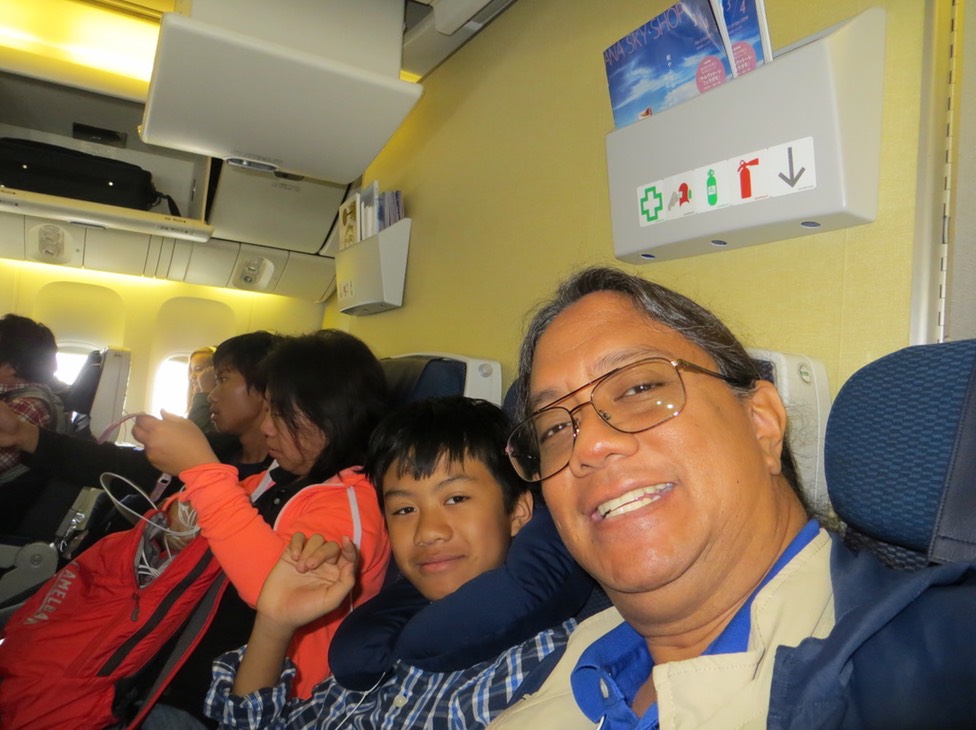
On April 1, after the boys had served at Easter Vigil Mass the night before, we flew from LAX to Tokyo Narita International Airport, landing late in the afternoon on April 2, local time. I rented a mobile hotspot for the week, picking it up in the terminal. It turned out to be one of the best things I did at the start of the vacation. Although WiFi is widely available in various hotels and other buildings, the mobile hotspot was something we could carry and have with us all the time. Coverage was very good throughout the vacation.
(On the flight over, I watched a woman/girl across the aisle take 40 minutes to apply her makeup. I went to the lavatory about halfway through and was appalled to find her still brushing her face and applying whatever when I got back. Ick.)
We then boarded the Narita Express to Shinjuku Station, where we picked up a taxi to our hotel, the RIHGA Royal Hotel Tokyo. It’s a nice hotel in a quiet neighborhood, right next to Waseda University but with easy subway access at nearby Waseda Station just a few blocks away. It’s also a business hotel, rather than a tourist hotel or resort, but service was extremely friendly, polite and efficient. The staff all spoke English well; I had brushed up on my basic Japanese prior to this vacation and found I didn’t need much beyond arigato gozaimasu. We later learned they say okini in Kyoto, rather than arigato. For the taxi ride to the hotel, I had written down the hotel address in Japanese as well as English, for the taxi driver.
 That evening, after checking in, we wandered around the neighborhood at night, looking for dinner and eventually settling on a tiny sushi bar right around the corner from the hotel. When we walked in, a little old lady was sitting at the bar, watching television, but she got up and started preparing stuff in the kitchen. Her husband, the sushi chef, walked in the front door, went behind the bar, and started preparing a sushi assortment dinner for each of us. The final cost was about $40 (US), for the four of us, which was astonishing. I think the same would have cost $50-60 in Pasadena. We started questioning our assumptions about the expense of this trip, apart from the plane flight and hotel charges.
That evening, after checking in, we wandered around the neighborhood at night, looking for dinner and eventually settling on a tiny sushi bar right around the corner from the hotel. When we walked in, a little old lady was sitting at the bar, watching television, but she got up and started preparing stuff in the kitchen. Her husband, the sushi chef, walked in the front door, went behind the bar, and started preparing a sushi assortment dinner for each of us. The final cost was about $40 (US), for the four of us, which was astonishing. I think the same would have cost $50-60 in Pasadena. We started questioning our assumptions about the expense of this trip, apart from the plane flight and hotel charges.
We also found a 7-11 down the street from our hotel, which turned out to be useful later.
 April 3 was our first full day in Tokyo, and we got some very useful directions and maps of the subway system from the extremely friendly and helpful hotel staff, who helped us figure out navigation, initially. Later, I used Apple Maps — rather than Google Maps — to help us navigate the subway and train system. We immediately ran into a problem when we bought Tokyo Metro all day passes, forgetting that the JR Line subways and trains are separate (a competitor), so we had to buy all day JR Line passes as well. The next day we bought combined passes.
April 3 was our first full day in Tokyo, and we got some very useful directions and maps of the subway system from the extremely friendly and helpful hotel staff, who helped us figure out navigation, initially. Later, I used Apple Maps — rather than Google Maps — to help us navigate the subway and train system. We immediately ran into a problem when we bought Tokyo Metro all day passes, forgetting that the JR Line subways and trains are separate (a competitor), so we had to buy all day JR Line passes as well. The next day we bought combined passes.
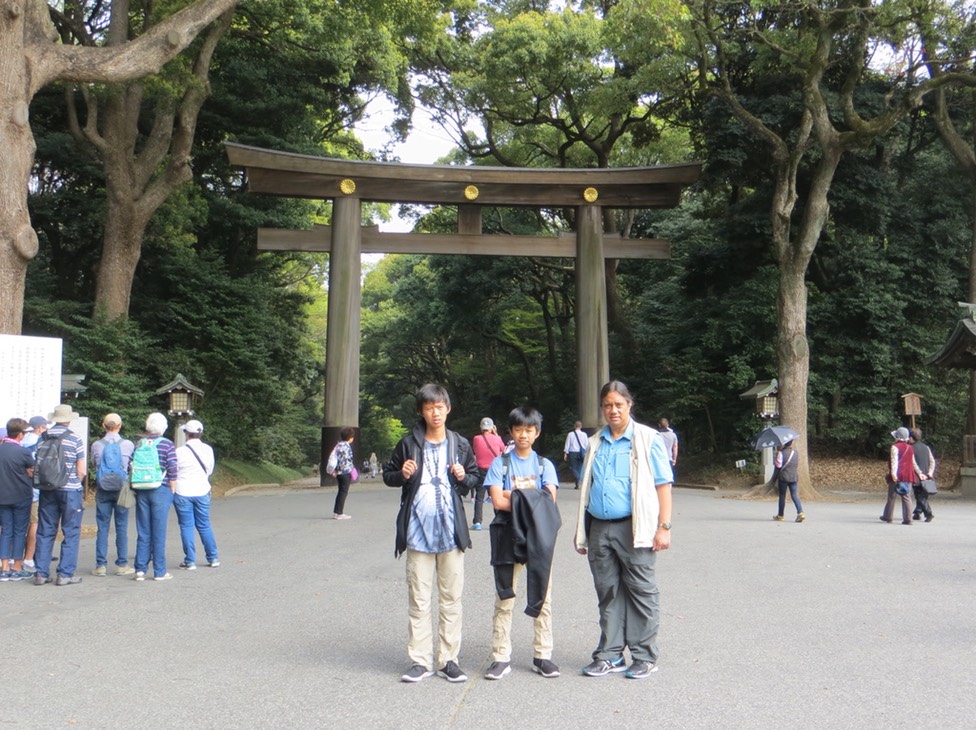

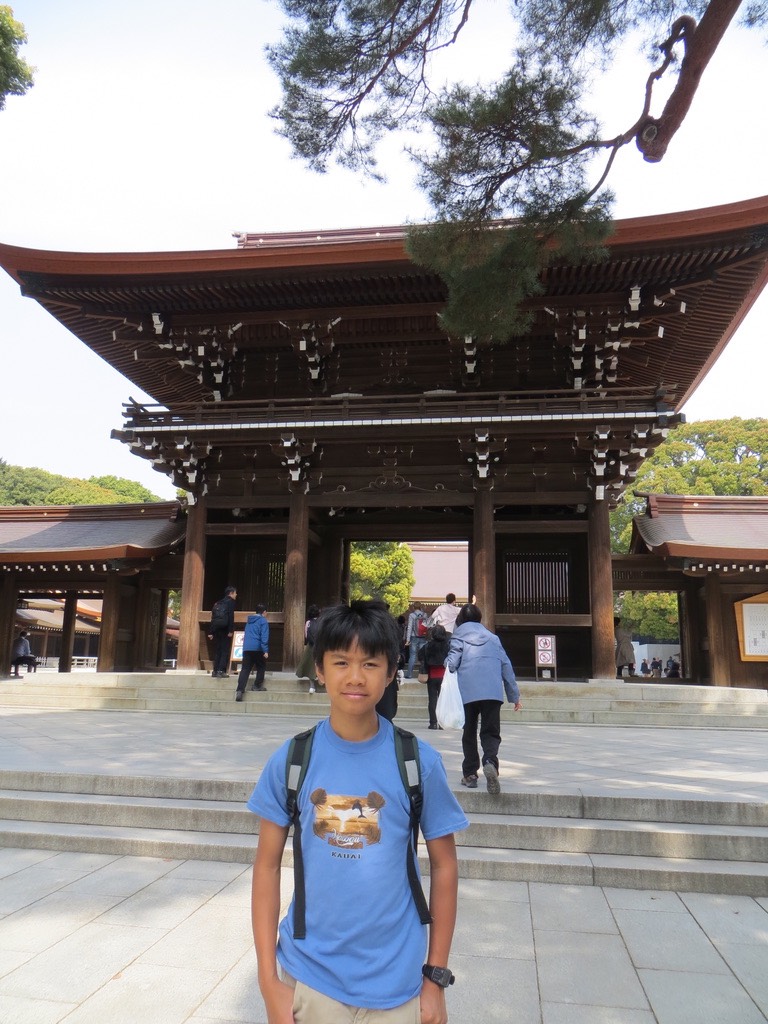

Our first stop was the Meiji Jingu Shrine, dedicated to the Emperor Meiji and his Empress. Emperor Meiji was the beneficiary of the Meiji Restoration, which returned authority from the Shoguns to the Emperor, and he was the Emperor who set about modernizing Japan. Basically, he’s the Emperor portrayed in The Last Samurai. Since the Emperor died in 1912, this isn’t an ancient shrine. Regardless, it’s very beautiful and well laid-out. It contains a garden that was enjoyed by the Emperor and Empress, with a small pond for fishing.

After spending the morning wandering around Meiji Jingu — disappointed to find the museum at one end closed — we took the subway to Otemachi Station, near the Imperial East Gardens, and we walked to Tokyo Station for lunch. Unfortunately, that’s right in the middle of the business center of Tokyo, and it was lunchtime for all the salary men and women. We snagged some ramen at a little ramen shop. You tap your order into a machine at the entrance, put in some money, and get a ticket with your order, and then, when a table is available, you hand the tickets from the machine to a waitress. Unfortunately, we needed some help with the machine, and while the boys and I got some nice, tasty ramen (mine and J’s included chicken karaage), Hsuan chose a spicy bowl that was spicier than she expected.
The place was packed to the gills, with a line at the entrance. All of the restaurants in this underground shopping mall seemed that way, full of business people, until we found some side “streets” in the mall with more wide-open, sit-down restaurants. Apparently, we chose the area with the smaller, faster restaurants frequented by lunchtime business people, rather than the slower, more out of the way restaurants that might have been easier for us, as tourists who didn’t need to get back to work immediately.
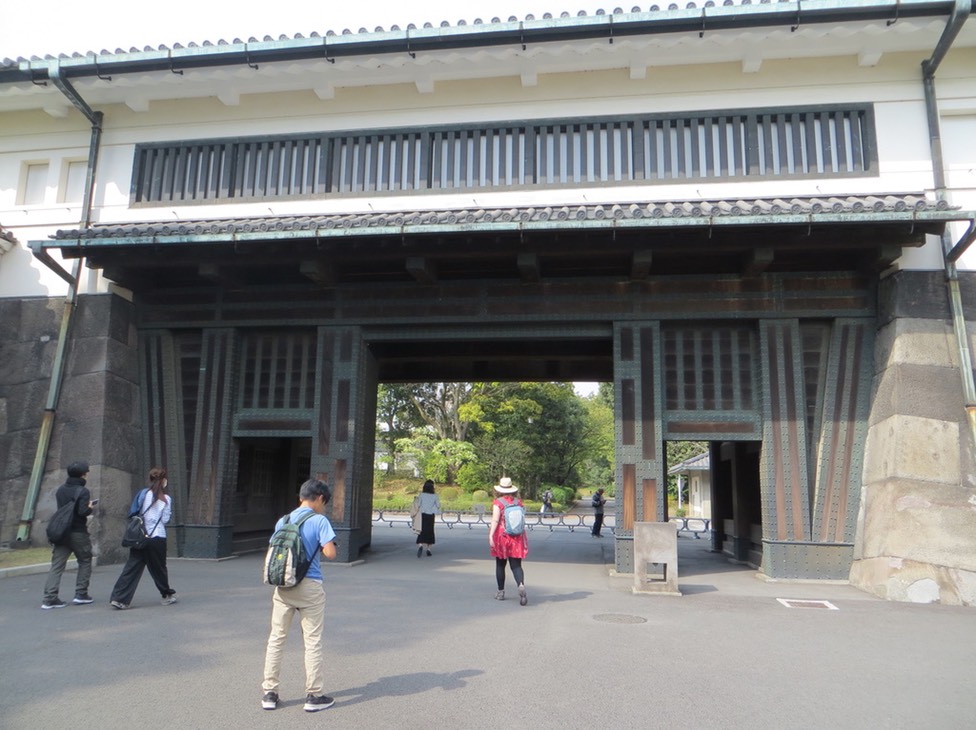
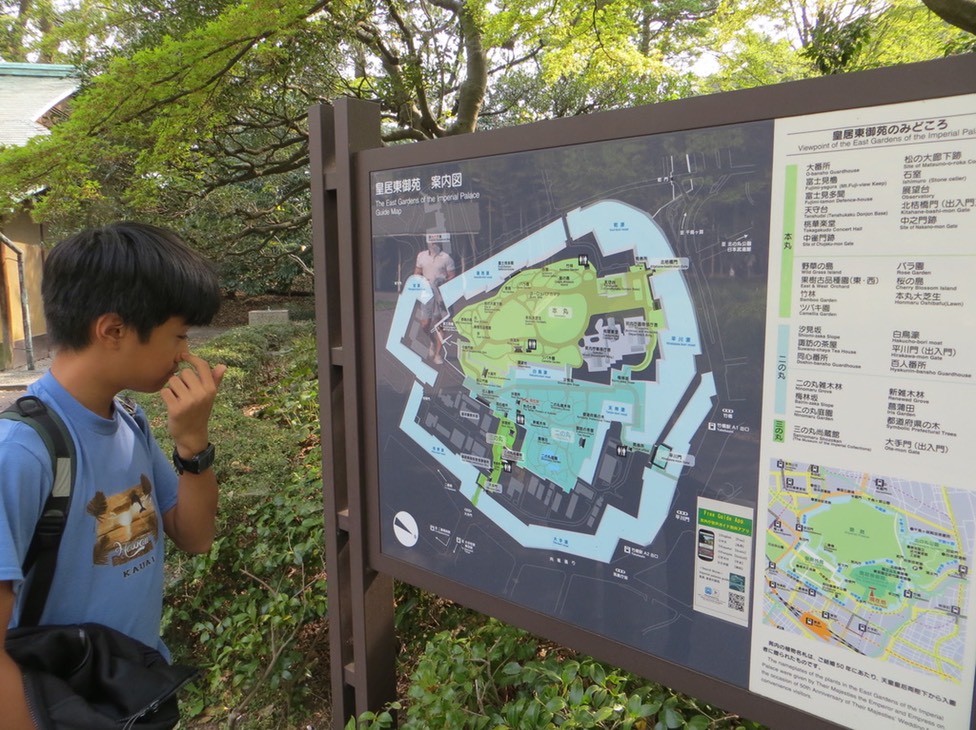

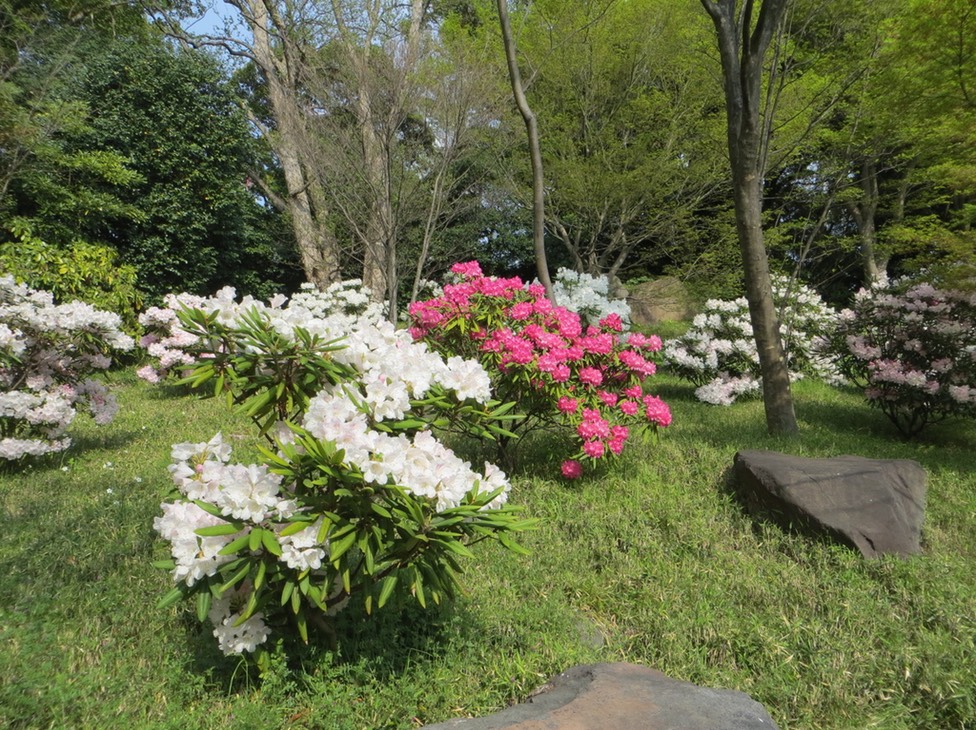
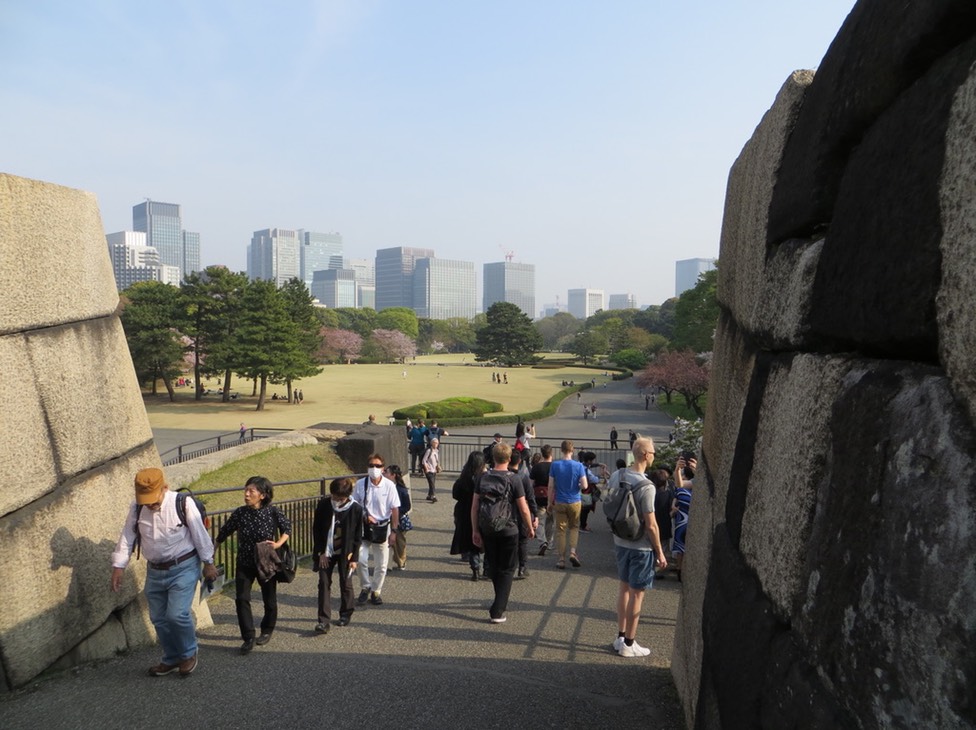
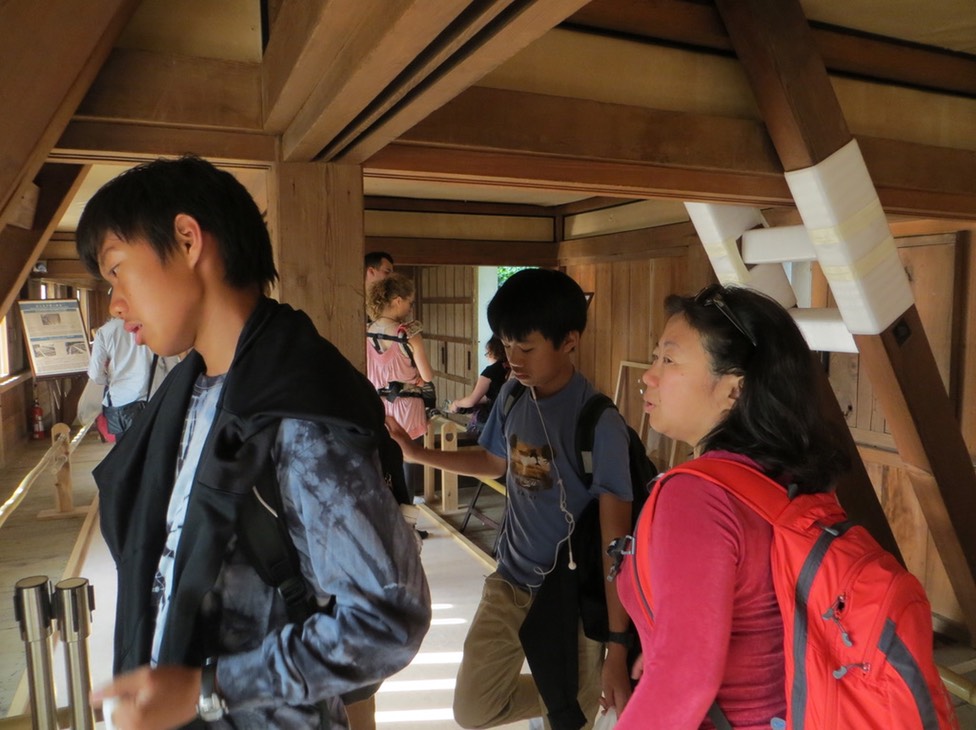
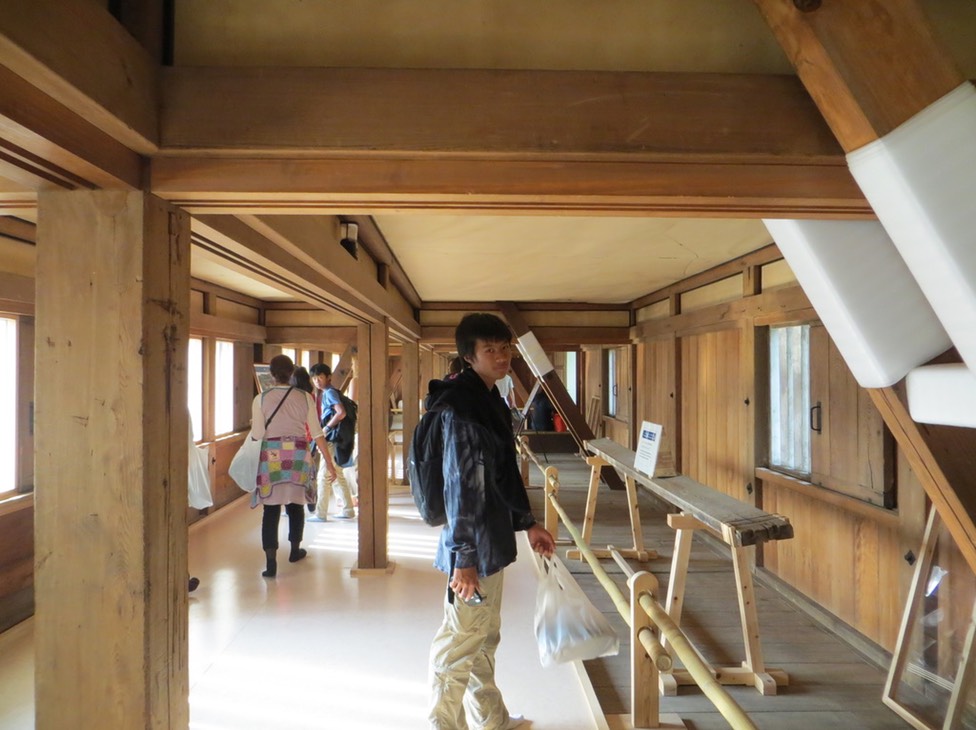

After lunch, we visited the East Gardens of the Imperal Palace, nearby. The gardens are two large gardens — they’d be called large parks anyplace else — adjacent to the Imperial Palace. The Palace isn’t grenerally open to the public, but the East Gardens are. It was another beautiful, peaceful garden, so huge that even the large numbers of people wandered freely about. Interestingly, there were defensive structures around the garden. I later learned that Edo Castle, upon which the Imperial Palace is now built, was formerly the residence of the Shogun (including Tokegawa Ieyasu). We learned in Kyoto that shoguns had to worry about assassination and attacks, but the Emperor — being divine — never had to worry about being assassinated. Thus, except for castles taken over by the Emperor from Shoguns in later years, Emperors’ palaces didn’t have moats and defensive structures, while Shogun castles did.
It was getting late in the afternoon. I had originally planned that we would visit the Senso-ji Temple in Asakusa and the Samurai Museum in Shinjuku, but since we also wanted dinner, since we were getting tired, and since we the museum closed at 9:30 PM, we decided to put off both for the next day and visit Akihabara instead.





Akihabara is world-renowned as the place to go for all kinds of electronics and other gadgets, not to mention cosplay and such. What we found on the streets outside of Akihabara station was a violent, bewildering sensory assault of a bazillion electronics stores, bright flashing lights and signs, storefronts packed with cameras and God knows what else, maid cafes, and crowds of people walking everywhere. There was a group of buildings and alleys across the street from the station called Electric Town, and it seemed to be the place to go. However, when we crossed the street to see it, it was even more densely packed with stores and people.
I’ve seen streets in New York City crammed with “camera and electronics” stores, but Akihabara sneers at such pathetic, amateur displays. I didn’t take pictures on the streets in Akihabara because I was afraid my camera would explode.
W was getting confused with the sensory overload. I checked TripAdvisor and various websites, looking for “things to do in Akihabara”. TripAdvisor said there was a Sony Plaza in the area, but I couldn’t locate it. Hsuan suggested visiting a maid cafe, but I didn’t think it would be either age-appropriate for J or any less jarring for W. Instead, I found out that there was a single, big, electronics superstore nearby called Yodobashi Akiba, so I decided we’d walk there. Surely there would be some sense of order there.
However, while it was far less crowded and confusing than the streets, it was still 9 floors jammed with electronics, toys, computers, cell phones, appliances, etc. Think Best Buy on mega-steroids, the kind that give you brain and testicular cancer so much your balls swell to watermelon-size and your brains pop out your ears and nose.
Throughout the whole experience, W and J started taking refuge in their iPhones.
We finally decided to return to the hotel by subway and train, where we all pretty much fell asleep, exhausted from the day’s walking. I wound up getting food from the 7-11, but the boys immediately went to sleep.
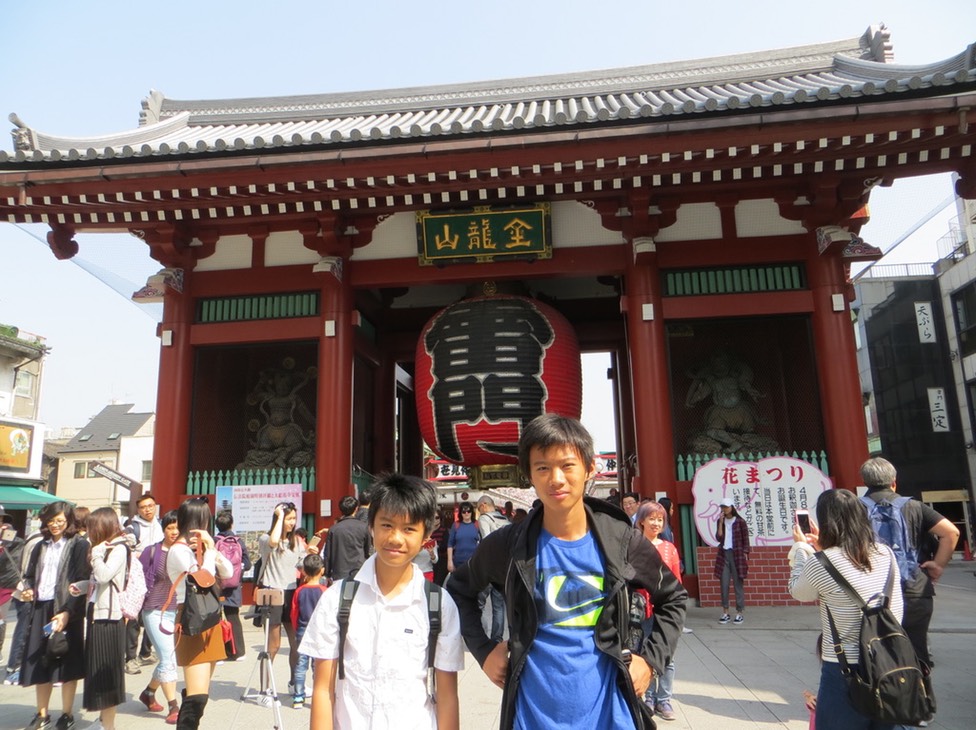
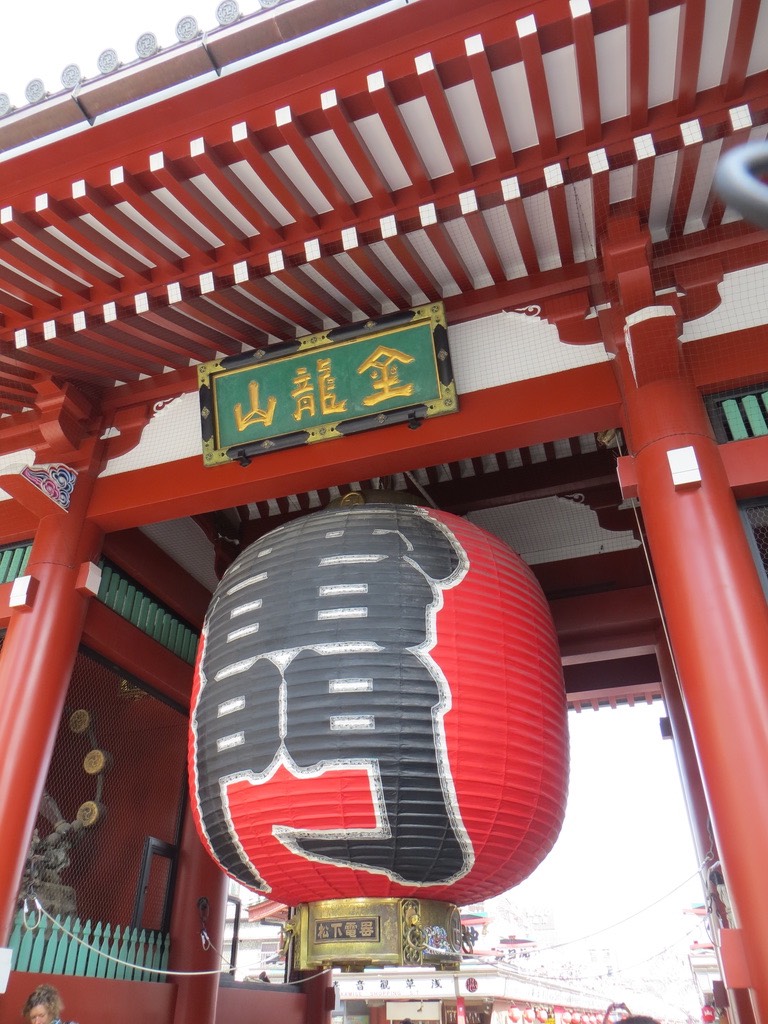


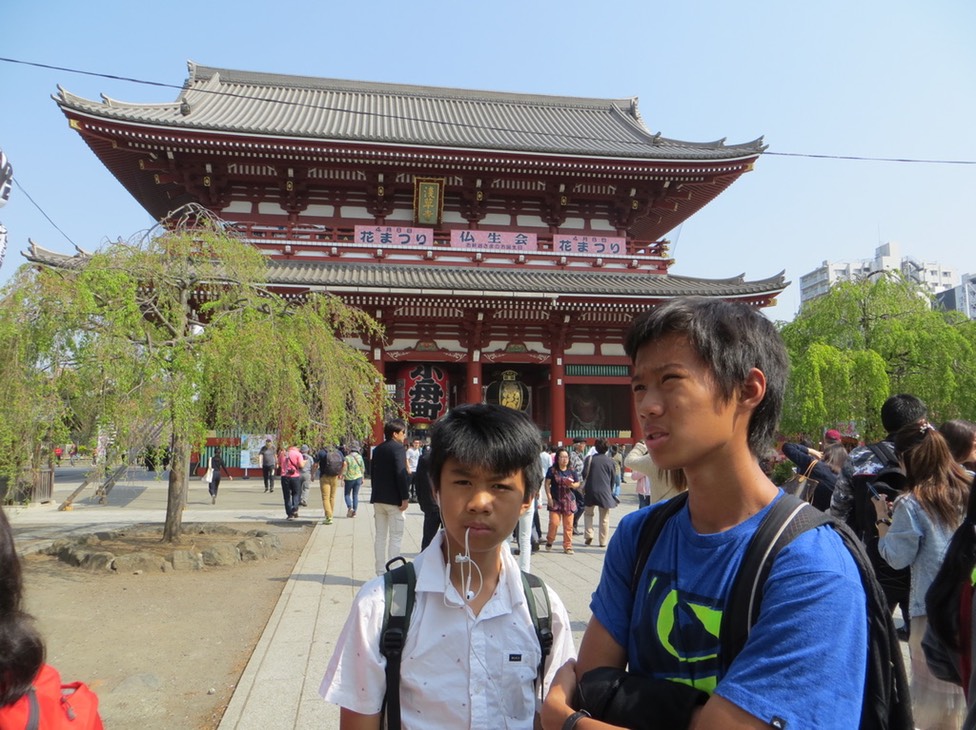

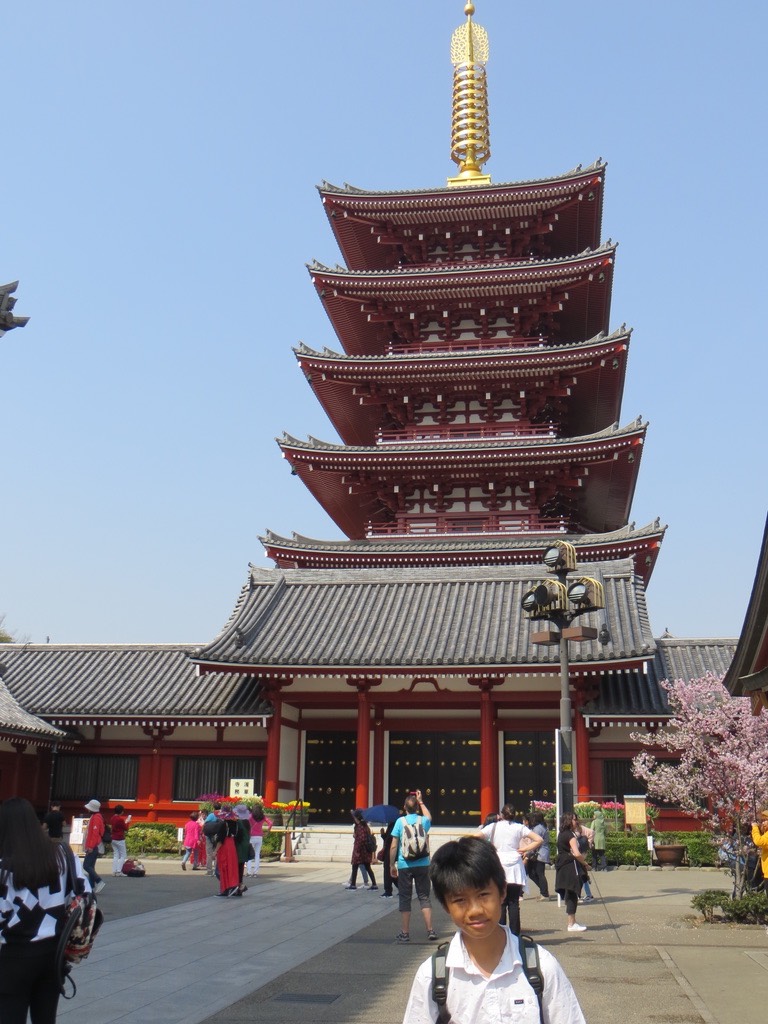
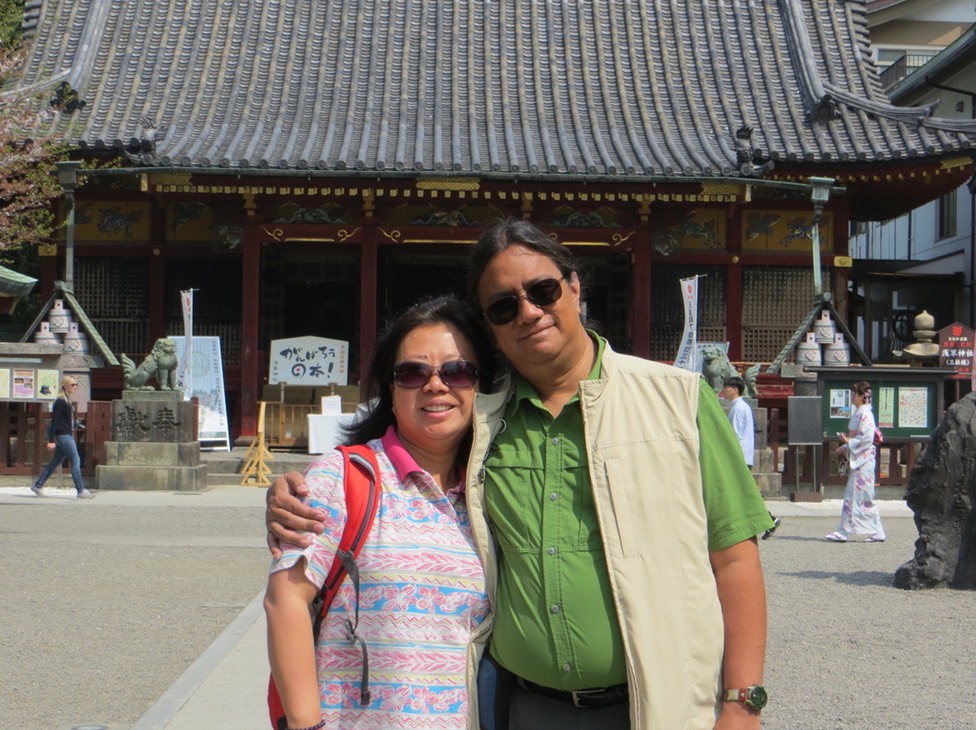


There’s always money in the banana stand.
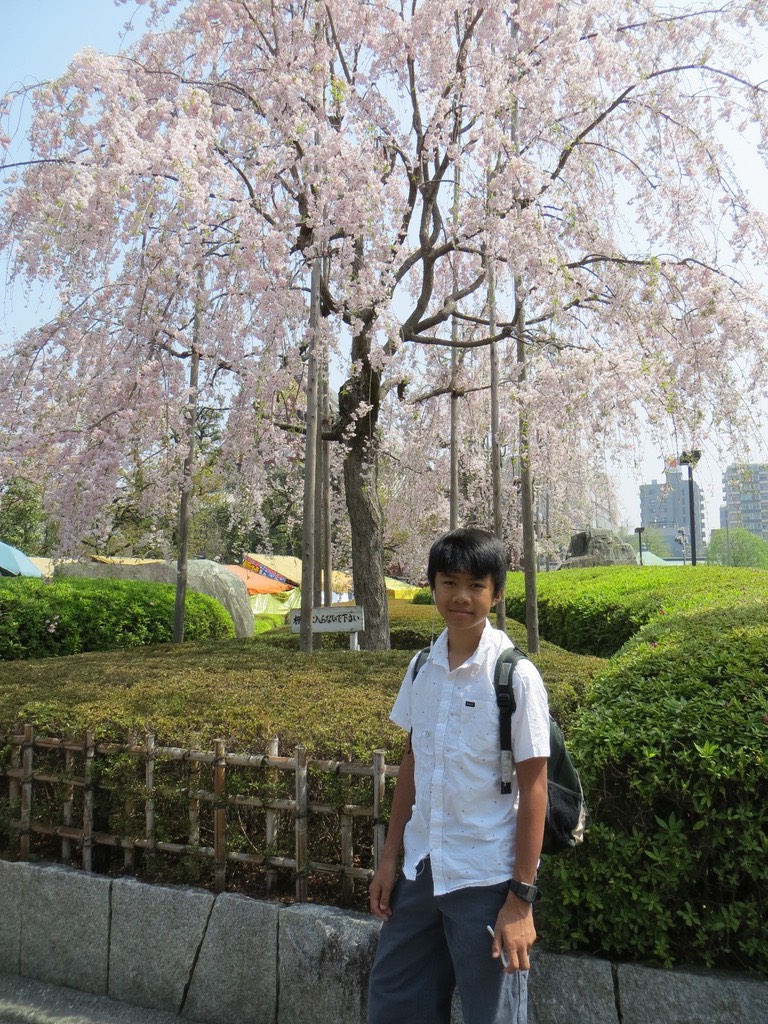
On April 4, our third day of vacation, we took the subways to Senso-ji Temple. It’s actually a temple complex that’s a mix of Buddhist temples and Shinto Shrines, including Asakusa Shrine, plus a bunch of vendor stalls selling food and souvenirs. J decided he really likes the street food, which was cheap and tasty.
Photos were forbidden inside the main temple, but people were taking photos of the religious service going on in there anyway. I didn’t take photos there, though. Hsuan and the boys both spent about 100 yen apiece to get their fortunes — shake some some sticks out of a shaker can, read the number, then take a fortune slip out of a drawer with that number. W got a very good fortune (i.e. successful this or that, lucky this or that, good time to build a house, boyfriend or girlfriend coming soon), Hsuan got a lame fortune (i.e. maybe good, maybe not, could be successful, or not, maybe a good time to build a house, or not,… blah blah blah), and J got a bad fortune (not successful, bad time to build a house, long wait for boyfriend or girlfriend, blah blah blah), which ticked him off.





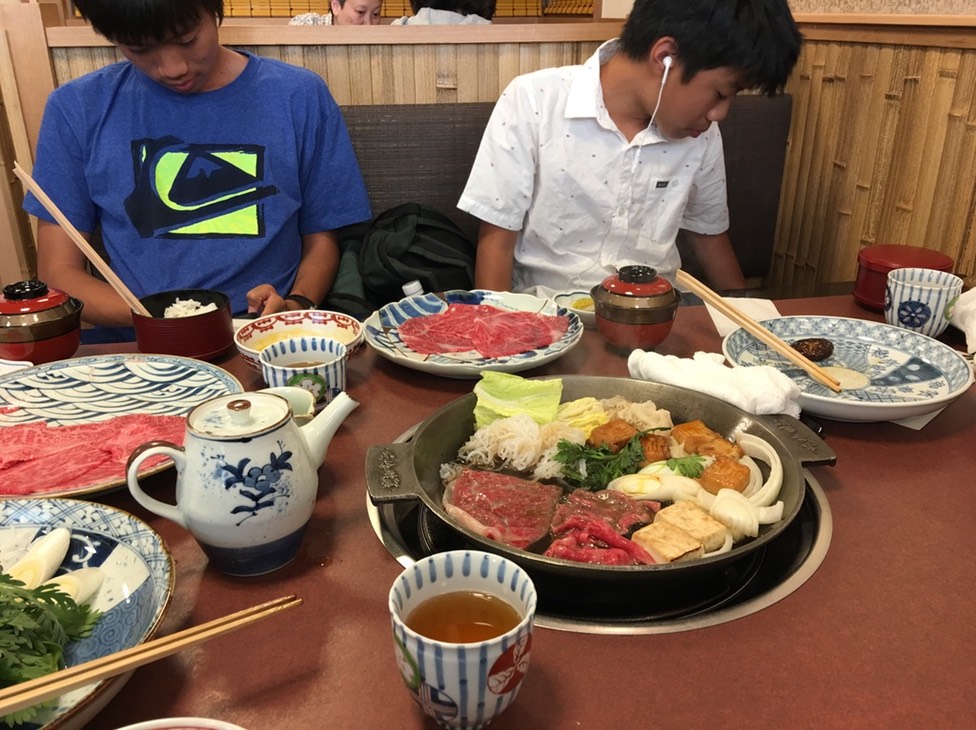
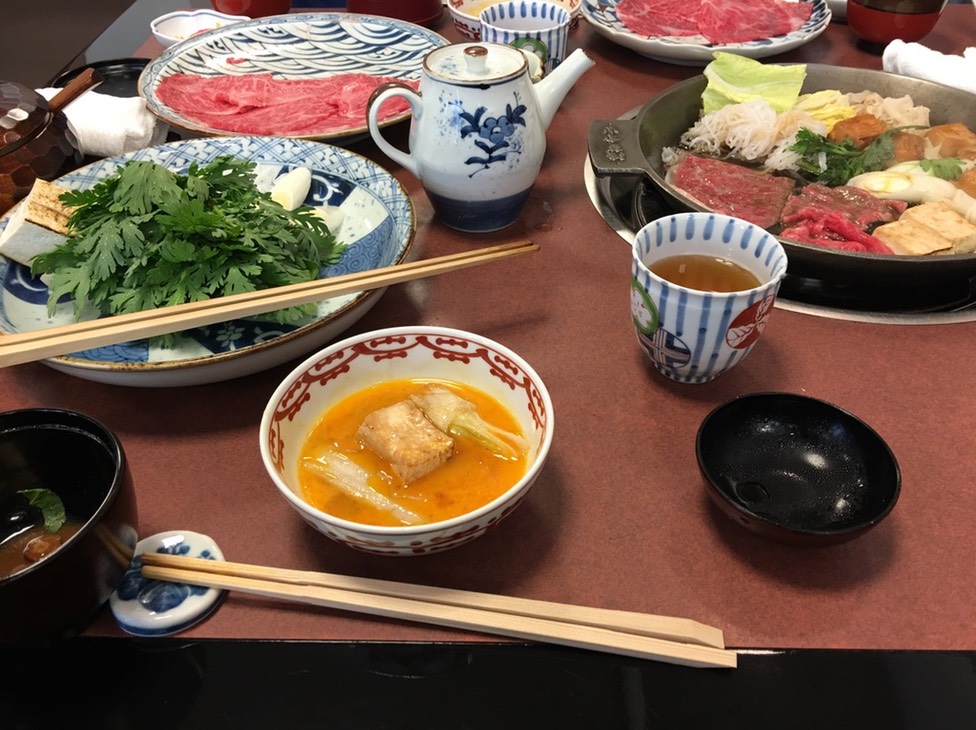


Despite the abundance of street food, I was hungry for some Japanese barbecue, and I decided we’d try to have lunch at the Asakusa Char-Grill restaurant nearby, but unfortunately we arrived and found it didn’t open until 2 PM. However, around the block we had seen a line standing outside of a restaurant, so assuming the line meant it was good, we got in line in time for opening and then had to wait, as all the people just in front of us filled up the tables. Still, we were told an hour’s wait, and it wound up being only 40-45 minutes.
We were very lucky that the barbecue restaurant was closed, because we had gotten into the Asakusa Imahan Kokusai Dori Honten restaurant. The Asakusa Imahan is a company that produces its own, exclusively labeled Imahan Wagyu Beef, and the restaurant we were eating at is the company’s head restaurant. We all had sukiyaki — Hsuan and the boys had their lunch beef sukiyaki sets, while I splurged on the Kobe Beef sukiyaki course. I traded some beef with W and J, so they could try it out. Their beef was just as tasty as the Kobe, which, however, was noticeably more tender. (The lunch sukiyaki beef was very tender, too, just not as fall-apart tender as the Kobe beef.)
All tables were served by elegant ladies in kimonos. Ours waitress started the cooking for us, but we took over once we got the vegetables going. J later said this was his favorite experience during the vacation.




We returned briefly to the Senso-ji temple complex for a little more street food, then we took the subway to Ginza for a little window shopping and to visit the Sony Store there. We also stopped by the Apple Store in Ginza; Hsuan’s iPhone X stopped charging the night before we left home, but it was unclear what a Japanese Apple Store could do for her, practically.
Then, before returning to the hotel, we went to Tokyo Tower, got tickets, and went to the main observation deck to view Tokyo in its nighttime glory.
I knew by now we had to give up on the Samurai Museum in Shinjuku. At best, we’d have an hour there, hardly worth the admission fee. Back in the hotel room, I searched TripAdvisor for similar Samurai attractions we might visit in Kyoto, and I found the Kyoto Samurai Experience and the Samurai Kembu Theater. I wanted the first, but when I went to book online, I found that the were booked solid until April 14. I e-mailed them, just in case they had a cancellation for April 7, when we could visit, and then I decided to keep an eye on the second one, which still had availability for the 7th.
Hsuan and W had a late dinner at a teppanyaki restaurant nearby, discovering they had problems with the language. J and I fell asleep in the room, so Hsuan brought back more food from 7-11 afterward.